#jack jeanne interview
Text
Jack Jeanne Complete Collection - Interview with Ishida Sui and Towada Shin Translation
This interview is from the Jack Jeanne Complete Collection art book, it’s available on CDJapan and Amazon jp. You can also purchase a digital only version on bookwalker jp. I encourage anyone reading to purchase the game (if you haven't already) or the art book itself to support Ishida and Towada directly. 💕
This is a VERY long interview so I apologise for any typos or errors I may have missed.
~ ~ ~
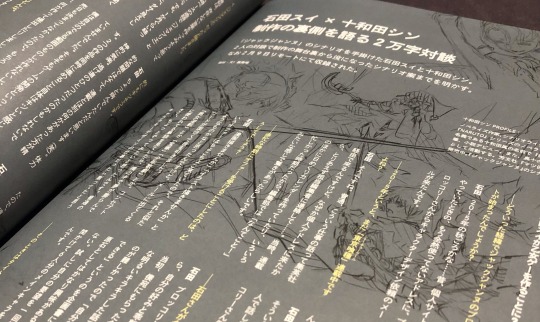
An interview with Ishida Sui and Towada Shin, who both worked on writing the story of Jack Jeanne. In this interview they reveal what went on behind the scenes during production, rejected story ideas and much more. This interview was conducted remotely on the 9th of February 2021.
Interviewer: Yui Kashima
How did Ishida Sui end up making an otome game?
—How did the production of Jack Jeanne begin?
Ishida: It was sometime around Autumn 2015 I think… On an old personal site that I used to run, I received an email from the company Broccoli to an email address that I no longer use. It was a commission request for character designs.
—In 2015 Tokyo Ghoul was still being serialised wasn’t it?
Ishida: Yes. Usually job offers like that go through Shueisha first, so I contacted my editor asking why this one was sent to my private email… At the time, in addition to working on Tokyo Ghoul, I was also drawing illustrations for a tear-off calendar and very busy with various other things, so when my editorial department heard about the offer they seemed very shocked like "What!?".
—Why did you decide to accept the offer even though you were so busy?
Ishida: I would often receive offers asking for me to draw manga or illustrations, so I figured that this one was a similar case. However, some words in the email caught my eye. Like ‘Gender Swap’, ‘Takarazuka’ and ‘All Boys Opera'. When I saw these concept ideas, a dream began to swell in my chest and I felt like giving it a try.
I think if it had just been a normal character design job, I would have turned it down. However just from reading the short brief in the email my interest was piqued. While in discussions with the Young Jump editorial department, I also casually mentioned the kind of offer I’d received to Towada-san.
Towada: Yeah, Ishida-san asked me for some advice. I was also drawn to the ‘Gender Swap’ and ‘Opera’ concepts. I could easily visualise the setting of the story. Additionally, it seemed like it would be a story that included many different themes such as gender. When I thought about that, I figured that Ishida-san would be a good fit, since I knew he would be able to draw something that went beyond all genders.
Ishida: I’ve been drawing androgynous characters for a long time, so Towada-san and I talked and wondered if that's what they must be looking for. After that, I created my own proposal and submitted it to Broccoli.
—You created your own proposal, Ishida-san?
Ishida: When I looked at the original proposal that Broccoli had sent me, a lot of it differed from my personal tastes. It was a very upbeat and dazzling story. It would’ve been hard for me to match my art style to that, so in my proposal I noted things like ‘if it were me, I’d do something more like this’. I was interested in this unpolished gem of a story, so I thought it would be a waste to turn it down altogether. I wanted to at least try throwing my own ideas into the ring, so I spent a week creating the six main characters and sent them in.
—At that time, I heard that the game wasn’t titled ‘Jack Jeanne’ yet, but was instead called ‘Jiemarie’.
Ishida: At first, I wanted to try creating a word that doesn’t exist. So using French as a base, I came up with ‘Jiemarie’ as the game's provisional title. But then a month later when I was reconsidering the title, I looked at it again and thought, damn this looks lame. So I hurriedly called Towada-san on Skype and we entered a discussion that lasted about ten hours over what the title should be.
That’s when we decided on ‘Jack Jeanne’. The male roles take the name from the knight, or the ‘Jack’ in a deck of playing cards. And the female roles ‘Jeanne’ take from the word parisienne and Jeanne d’Arc. When these two terms are put together, I feel like you can comprehend what the game is about with a bit of nuance. Plus you can shorten it to ‘JJ’… That’s also the title of a magazine though (lol).
—Taking on another job whilst your manga was being serialised sounds like it would be tough on you both physically and mentally.
Ishida: I think I must’ve been a bit unwell (lol). My body was fine, but being able to work on something other than a serialised manga was a lot easier on me mentally. I may have seen it as a way to escape, so I didn’t feel that working on two projects at the same time was difficult. When it comes to game development, I can only create what I’m capable of, and there was no set release date yet. Of course, I would work on and submit things whenever I could though.
—What kind of things would you submit?
Ishida: I would sketch character designs, discuss and create story elements with Towada-san and try to put Univeils history into chronological order. Then I would share the progress with Broccoli and have meetings and such with them. In the beginning, rather than having to draw anything yet, it was mostly just brainstorming and planning. That’s why I think I was able to do it all concurrently with the serialisation of my manga.
~ ~ ~
How Ishida Sui and Towada Shin know each other
—Do you chat with Towada-san often?
Ishida: Well yeah, she is my older sister after all.
Towada: We talk a lot. When we both have the time we chat over Skype.
Ishida: Once we start the conversation can last up to five or six hours. We mostly talk about things that happened throughout our day. When I’m talking to someone I often bring up something that’s happened to me and ask their opinion on it. She became someone that I could chat with whilst working on my manga. Ever since my student days we’d talk until early morning, I usually told her about storyboards I’d drawn.
—At the Ishida Sui exhibition it was revealed that Towada-san had even given you advice on some of your earliest works.
Ishida: Yeah that’s right. It was a work I’d prepared for a 'bring your own work along' induction course in Tokyo that I attended back in my student days. It was a manga about two characters who eventually became the prototypes for Tsukiyama and Hori Chie in Tokyo Ghoul. It was only about 30 pages long, however when I showed it to Towada-san the day before the presentation, she told me that she thought my linework was too thin.
Towada: Yeah, the overall linework of the manga was thinly drawn. Once I told Ishida-san this thought, he began tracing over his linework and making it thicker. And then when he looked at it again, he said “Yep, I need to redraw the whole thing”.
The linework being too thin was only my personal opinion and the presentation was in Tokyo the next day, so in horror, I began hastily telling him, “You won’t make it in time, stop, stop!”
Ishida: All I could think about was that the lines really were too thin, so I wanted to redraw it. All of the screentones had already been affixed to the panels, but I didn’t want to bring something along with me whilst knowing it wasn’t the best that it could be.
Towada: Ishida-san handled the linework and I helped with redoing the screentones. We worked throughout the night and finished redrawing the whole manuscript. Once it was done, it wasn’t even comparable to the previous version, the lines were powerful and the characters' expressions conveyed a lot. I was seriously worried though (lol), I didn’t know if we’d complete it in time.
Ishida: I couldn’t think about anything other than the lines being too thin, so I wasn’t even worried about whether I had enough time or not.
Towada: I fell asleep halfway through, but you continued and boarded that Tokyo bound flight without having slept a wink, didn’t you?
Ishida: Yeah. I let Towada-san sleep and continued applying the screentones myself right up until the very last minute. I was still applying them whilst on the plane and also after my arrival in Tokyo. I used screentone number 10 a lot, so I remember the scenery around me gradually began to look grainy like the screentone. It felt as though I was hallucinating.
—Sounds like it was a tough manuscript to complete. Towada-san was also the author for the Tokyo Ghoul novels, has your relationship always been one akin to work partners?
Ishida: When it was decided that Tokyo Ghoul would be getting a novelisation, I was given other authors' works to look at. However, none of their styles really clicked with me, and they didn’t seem right for the series. I knew that Towada-san wrote, so I tried reaching out to her.
Although back in the days of Tokyo Ghoul’s serialisation, Towada-san and I didn’t talk as much as we do now. If I had any concerns I would just try and sort them out by myself. We’d always gotten along as brother and sister, however we didn’t really start to have a ‘work partners’ kind of relationship until we started working on Jack Jeanne together.
Towada: That’s true. Back then, we only occasionally conversed regarding the novelisation of Tokyo Ghoul. Before :re we only spoke once every few months over Skype. As Ishida-san said, it wasn’t until I started working on Jack Jeanne that we really started properly talking to one another.
—How often would you contact each other?
Towada: Depending on what stage we were at, we would bounce ideas off each other once every three or so days. Ishida-san would make a request like “I’d be happy if this part of the script was done within the next two weeks.” And then I’d present what I’d written and we’d discuss it and then I’d return to writing again. This process was repeated until Jack Jeanne reached its completion.
—Was Ishida-san the one that reached out to Towada-san to write the script of Jack Janne?
Towada: He didn’t ask me specifically to write the script, early in development he’d ask me to help with some research like “I’d like you to look up some information on this, could you help me?”. I’ve always liked ikusei games and within that genre I also enjoy romance and otome games. So I think that’s why it was easy for Ishida-san to consult me about it. We’ve had a common interest in games ever since we were kids.
Ishida: Back then I played games like ‘Pinnochia no Miru Yume’ and ‘Angelique’. I wanted to try and conquer Marcel in Angelique but it was one difficult game, so it was a tough task. Before I could even raise any flags with him, the training aspect of the game was so hard that no matter how many times I played I never got any good at it.
Towada: I’m the type that loves playing games, so after talking with Ishida-san, I went on to play every popular otome game that had been released around 2015, as well as every Broccoli published otoge. I completed every single character route in those games. I began analysing otome game trends and Broccoli’s brand identity and relayed my findings to Ishida-san. After that, I went along with the Jack Jeanne production team and Makasano Chuuji-san from Shueisha, who was the scriptwriter of the Tokyo Ghoul anime. We all visited the city of Takarazuka for research.
Ishida: I was also supposed to be there for the Takarazuka trip but since I had my manga to worry about, I had Towada-san go and take in the atmosphere in my place.
Towada: I did have to gather material but I think I visited Takarazuka a total of five or six times. From morning I would watch the Takarazuka theatre from afar and simply watch the guests move about, soaking in the atmosphere of the city.
Along with the Takarazuka plays, I also watched student plays, in total I probably went and watched one hundred shows. Theatre shows that are performed by professionals are fully realised and flawless. So getting to see the contrast to student plays, where they progress and improve until the show is complete was a very helpful reference.
I’ve always enjoyed watching plays, so everything I had to research overlapped with my own hobbies. I still shared my own input with Ishida-san though.
Ishida: I’d never formally been asked to write a script before… I felt like a fraud (lol). I think it’s because I’m not very good at being considerate of other people. I don’t think I’d be able to work with anyone other than Towada-san on something.
—Why is that?
Ishida: Well, for one I don’t want to talk to anyone for long periods of time (lol). Because Towada-san understands what aspects of a story are important to me, she’s also able to comprehend what I mean when I talk in abstract concepts. We could save time by not needing to have any pointless discussions.
Towada: Back then Ishida-san was still very busy publishing his manga, so bringing in all sorts of new people to work on the project probably would’ve put quite the burden on him. That’s why I wanted to help him out in some way.
After researching all sorts of things, I ended up participating in a production meeting for Jack Jeanne, but I was not expecting that I myself would end up being in charge of writing the script. Rather, I was more just looking forward to getting to play a game made by Ishida-san. As things progressed though, I was asked to try plotting things out, or to write part of the script to be used temporarily. Eventually I came to think, why don’t I just write the scenario myself?
I’d never written the script for a game before though, so that’s what had been holding me back. Unlike novels, it’s commonplace to not have to write descriptively. Novels are made up of dialogue and descriptions, like describing the setting and characters' expressions or emotions. So I had to spend a lot of time working out how to write to properly convey a story through dialogue alone.
When I first started getting the hang of it, I tried writing a script that still included descriptions but I quickly stopped. Jack Jeanne is about theatre, so I figured that it would be easier to convey the presence and narrative of the story through conversation. I usually write novels, so I was uncertain, but since Jack Jeanne has sprites of the characters on screen, I thought that I could do it. I suppose it’s closer to writing for a manga rather than a novel.
~ ~ ~
The rejected character routes
—Before Tokyo Ghoul was completed, what kind of things did you work on?
Ishida: The first two years were mostly spent creating the game’s world and mechanics. Like deciding how many performances there would be, how the plays would be presented. Would it be a dialogue drama? Would there be mini games? Things like that. We also had to decide whether summer break would be included or not, how raising affection would work and how the choices would be presented. Those are the sort of things that were talked about first.
—You got to watch over the entire game’s development then.
Ishida: At first, I got carried away and envisioned a stage play game full of skill mechanics that I personally enjoyed. A busy game full of specs you can raise and improve in mini games, however when I explained these details to a friend of mine, they were like “You’re just imagining a game that you would like, right?”.
They asked me if that’s what the eventual players of Jack Jeanne would be looking for. That same friend said that since it’s a story that deals with the theme of theatre, it would be better if the player could witness the performances themselves. So I took that advice and the prototype of the current Jack Jeanne was created. I told all of this to Towada-san and had her handle the script.
Towada: You can’t write a script without knowing how the game’s system works after all.
Ishida: Now that I think about it, before Tokyo Ghoul was finished, rather than build the game's foundation, all I was really doing was scattering the sand to prepare for said foundation.
When Tokyo Ghoul entered its endgame especially, I really had to concentrate on it, so I took a six month break from Jack Jeanne. Ending a story requires a lot of energy and attention, so I left the practical work of Jack Jeanne to Towada-san and only supervised the music production and attended any important meetings.
—So during serialisation you were making preparations to jump right into it afterwards?
Ishida: Yes exactly. I wasn’t able to do much practical work, so I had Towada-san prepare the script in advance for me. And for the time being, create one character route.
—Which character was it?
Towada: It was Shirota. I wrote about the equivalent length of a short book and it was more or less complete. In the end, we scrapped the entire thing though… Because the atmosphere in the beginning was quite dark.
Ishida: It was dark because I was too used to Tokyo Ghoul. It included issues like a troubled household and severe bullying. Reading something like that wouldn’t put the player in a happy mood.
Despite it being a story about the theatre, my attention drifted to other topics which didn’t fit. And it was me who had asked Towada-san to write something like that… A couple months after the Shirota route had been completed, I read over what Towada-san had written for me once again and realised that it was a bit too gloomy. I’d forgotten what prompt I’d even given to her in the first place (lol).
The first character portraits and CGs that I created were for Shirota too. The reason being that Shirota is the only second year student and he was already a complete individual, so he was easy to create for. As for the third year students, there’s three of them, Fumi, Kai and Neji. Along with Kisa, Suzu and Yonoga are also first years, so continuity and character relationships need to be taken into account in order to create them, so they were a little more complex.
—How did the other characters come to be?
Ishida: At the proposal stage, the first character that I created was Kai. It’s a game where characters will be falling in love and confessing to one another, so first off I wanted a character that was handsome. Then I made Fumi who would be Kai’s partner. After that, I think Shirota was next.
Towada: At first you created the characters by basing them on plays didn’t you?
Ishida: I’m a fan of Yamamoto Shugoro’s work ‘Kikuchiyosho’ so Shirota was created using that as a base. In Shirota's case the genders are swapped, but Kikuchiyosho is a story about a girl who is born into a samurai family and raised as a boy. It has an element of androgyny and portrays the confusion and anger concerning gender quite well.
—How did you select the plays to base the characters on?
Ishida: I chose plays that lots of people are familiar with and would be easy to assign characters to. Kai is ‘The Phantom of the Opera’, Fumi is ‘Salome’, Neji is ‘Faust’ and Yonoga is ‘Shintokumaru’. Kisa and her classmate Ootori are ‘Don Quixote’. Ootori ended up becoming a side character though.
—So Ootori was originally meant to be a main character?
Ishida: Yeah. If I were to compare it to Tokyo Ghoul, Ootori is in the same position as Tsukiyama. I wanted a pompous character like that in Quartz. However I may have made him a little too unique (lol).
I received feedback from Broccoli that they want the main six characters to be an elite group, so a more easy to approach character would be better. So I moved the bright and cheerful character that I had originally made as Onyx’s Jack Ace over. That character was Suzu.
Making the characters personifications of plays started to become difficult to stick with though, so I abandoned the idea entirely halfway through.
—Despite appearing glamorous, the characters are all dealing with their own issues, like certain complexes and family troubles. I think that they’re all conflicts that are easy to sympathise with, how did you decide what the backbone of each character's conflict would be?
Ishida: First I created the character's appearance and then decided what personality would match them. Like with Fumi, when I began to think about making his story about the unique struggles that come with being born into a respected family, if becoming a successor was going to come into question, then he needed to have a brother.
In this way, I worked backwards from the vibe of his appearance and created his home life. I did the same with the other characters too, thinking things like ‘to have a personality like this they must not have parents, or they must struggle with expressing themselves’.
I think that if you let your characters do human-like things, then aspects of them that are easy to sympathise with will be born.
Jealousy, setbacks due to failure, inferiority complexes… Each and every character naturally ended up having some form of theme attached to them.
—I feel as though Kisa had a different sort of personality than that of a typical heroine.
Ishida: To put it simply, I want my protagonists to be fighting something. If they’re not giving it their all, then it’s no good. If they’re just standing around, then you can’t empathise with them.
—There’s times where she draws others towards her or supports those around her. She also has some masculine aspects to her.
Ishida: I think that I’m moved by characters who make me think “This kid’s really admirable”. That’s why I made Kisa a girl who works hard no matter the difficult situation that she’s in. I like Kisa and I’m sure Towada-san feels the same way.
Towada: She’s the result of both of our preferences. While due to the game’s setting, she of course has struggles related to being a girl, but I was careful to write the main thread of her story in a way that transcended gender and instead simply showed her charm as a human being.
—Regarding gender, I was impressed by how neutrally it was portrayed.
Ishida: Yes. Originally, I was going to make Shirota a character with a feminine personality, but I ended up scrapping the idea. In the end, he ended up having more of a masculine mentality. The premise of Jack Jeanne is that boys also play the female roles on stage, but it’s not a metaphor for anything and I didn’t want it to raise any questions. I simply wanted to give it my all creating plays with that setting and create something new and refreshing.
I don’t struggle with any gender related issues myself, so it’s not like I can fully understand what it’s like, but in general I’ve never considered gender to be a very big deal. If someone born male were to tell me “I have the heart of a woman” then I’d just think ‘ok cool’.
To me it feels strange to place so much weight on such an issue. I don't see why others need to be bothered by someone else's gender, I'm not since I myself am not able to speak for such experiences.
Towada: At first, it was possible to take that direction with Shirota but as I continued to write, I came to realise that there was no need to exaggerate any emphasis on his gender identity.
To those looking from an outside perspective, it may seem like a unique identity such as that is a person's defining trait, when in reality it's only just a portion of their whole self. If you consider it to be all they are, then you end up denying the other aspects of that person.
Whilst considering the individually of each character, I kept in mind to write them in a way that seemed natural for them.
—The side character, Tanakamigi Chui of Amber, had a very striking presence. How did you go about creating him?
Ishida: I wanted someone that’s easily understood to be the antagonist, so I went ahead and tried to draw someone who looked like an unstoppable genius. Despite being a second year, it’s as if he controls the school. I wanted an enigmatic and intriguing character like that. Once I named him Tanakamigi Chui I felt as though he was complete and his inclusion in the story was quickly decided on.
—On the flip side, were there any characters that you had a hard time creating?
Ishida: I had to think a little harder about the other members of Amber. They needed to have the aura of the enemy but since they’re only villains in the context of the stage, they’re not actually bad people. So it was hard to find that balance between them.
Visually they’re edgy and have a talented vibe, but they also have their own individual quirks, they’re not all homogeneous. I struggled with Kamiya Utsuri especially, I wanted him to visually look like he could be a Jeanne while also still looking like a boy, so it was difficult to get him right. I didn’t have to do many redesigns though and all the other characters came to be without much trouble.
What I actually had more trouble with, was the fact I made the cast too large. I initially created almost double the amount of first year characters, but when I looked back over the script that Towada-san created, I told her “There’s way too many characters, please cut some of them out.” To which Towada-san replied, “Ishida-san, you’re the one who created them in the first place.” (lol).
Towada: That’s because the cut characters had already appeared in the script (lol).
Ishida: I feel that when there’s too many characters a lot of them get wasted, so just like that I end up creating and scrapping a lot of my characters. I think even Broccoli were surprised by the amount of times I’d suddenly tell them “Oh that character doesn’t exist anymore.”
—Apart from characters, were there any other aspects of the game that were abruptly discarded?
Ishida: The performances I suppose… Originally I had wanted there to be a larger variety of shows, but if you were to put all of them in the script it probably would’ve ended up being three million characters long.
In the beginning of development, I had originally planned for each character's route to have a different final performance. There’s six main characters, and including Kisa’s route, that would total to seven unique shows.
Before that there’s the newcomers, summer, autumn and winter performances, so I arranged to have a script written for each. Basically I wanted to include more shows and increase the amount of sub stories, but that would be confusing to play through and development would never end. The game engine has its limits too, so I decided to keep it simple.
Towada: It would’ve been difficult to play through all that as well (lol). For the final performance, we settled on it being one show and letting the player enjoy it from each character’s perspective instead. And even then, there’s still over 20 different endings to the game, so it still took a long time until everything was fully complete.
—Newcomers, summer, autumn, winter and the final performance, were these five show’s scripts all original?
Towada: Yes. However at first, like the characters, we had planned to base them on famous productions. Like Shakespeare or fairy tales. We figured that players would find it easy to get immersed in plays that they were already familiar with.
Ishida: For the newcomers' performance, I thought we could have a show called ‘House of Biscuits and Candy’ based on Hansel and Gretel. I had also originally planned to use each character's motif to base the plays on.
Towada: Like Shintokumaru, right?
Ishida: Yeah yeah. I even went as far as getting permission to use it, but if the show were to be following a story that already exists, then the script would be bound to it. Once I understood that it would make it difficult to relate the stories to Univeil, we decided to create the plays ourselves.
Since I acquired the permission to adapt Shintokumaru though, maybe I’ll have to make a manga about it someday…
By the way, the one who was saying “Let’s do this” and then changing it to “Nevermind let’s not” was all me. I’ll start on something wholeheartedly thinking that it’s the right choice before realising halfway through that I can’t actually take it anywhere and stop. Jack Jeanne’s development was full of trial and error.
Whenever I’m about to start something, Towada-san will express her concerns with my ideas but I always end up pushing on with them only to ultimately scrap it.
I probably have at least ten books worth of scrapped drafts alone. I had no real knowledge of how to properly craft a story. I hadn’t drawn anything other than Tokyo Ghoul, so even though I had no idea what the fundamentals of storytelling were, I misunderstood that I could write other kinds of stories too. This time around I studied and revised each time… I really learnt a lot.
Towada: You learn things by doing them, so I think I just got used to it (lol). Also, you don’t commonly see stories presented within stories, I thought that it was a rare case for a game especially.
~ ~ ~
The story behind ‘Lyrics: Ishida Sui’
—You also wrote the lyrics for each of the songs used in the performances didn’t you, Ishida-san?
Ishida: Yes, that’s how things ended up. It goes without saying, but no one, including myself, thought that I’d be the one writing the lyrics.
Originally Broccoli brought in several professional lyricists and had me look over what they’d written. However I couldn’t help but feel that they were lyrics I’d heard somewhere before, or they at least didn’t leave a unique impression on me. I did feel the finesse of a professional, and they were beautiful lyrics that fit the story in one way or another… But the words used didn’t touch on the core of the story.
The songs in Jack Jeanne are stage songs that Neji wrote for the members of Quartz. So unless you’re familiar with the setting and understand how the characters are feeling, then you won’t be able to write lyrics that perfectly fit the scenario.
While I knew that my lyric writing technique would be far from that of a professionals, I thought that no one understands and loves these characters more than me, so I approached Broccoli about it. I’d poured my heart into not only the character designs, but also the story and system of the game, so I didn’t want to compromise on the lyrics and have them pale in comparison.
So, to the best of my ability, I wanted to at least try my hand at writing them. I had Broccoli check whether or not what I’d written was viable and asked them “If there are no problems, then please let me write the lyrics.”
—Did you sing the temporary vocals for the songs too?
Ishida: When I submitted the lyrics to Broccoli, I got the normal response of “Thank you, we’ll leave the temporary vocals to you.” Along with this message they also wrote “You can hire a professional vocalist if you’d like, or you could record the temporary vocals yourself.”
Because of this I started thinking that maybe I should record them myself. Similar to how one wouldn’t be able to write lyrics for the songs without a deep understanding of the story, if you weren’t the one who wrote the lyrics, you wouldn’t know how they’re supposed to be sung either.
So, after deciding that I had to be the one to do it, I made preparations to acquire some audio recording equipment and downloaded some editing software. I divided up the parts and harmonised with myself and over the course of three days, I finished recording the temporary vocals. That’s more or less how I did it.
—When recording yourself singing, being self conscious about it can interfere, can’t it?
Ishida: I don’t think I was possessed by him or anything, but… When I tried to go all out, as expected I felt a bit hesitant, so I began recording whilst imagining I was Neji.
In the game, Neji is the one who writes the scripts, so surely he would also write the lyrics and subdivide the song and do everything himself. So I got through it thinking like that. In that pumped up mental state, I sent in the temporarily recorded songs but all Broccoli said back was “Alright, let us know your upcoming schedule”, I got so carried away that I was somewhat bewildered by the cold response (lol).
~ ~ ~
Recruiting via DM, gathering specifically selected creators
—It appears the creators you gathered to handle things such as the concept art and music are all people whose work you enjoy.
Ishida: Yes. Almost everyone was sent a targeted offer. For example, I’ve always loved the concept artist Lownine-san’s work ever since I was a student. I suppose you could say I was jealous of how high quality their artwork is… They’re someone who I thought I'd never be able to beat in my entire life. Lownine-san is an amazing artist who is especially good at blending characters into their backgrounds.
When we were creating Jack Jeanne, I wasn’t sure if I’d be able to pull something like that off, so I definitely wanted to recruit Lownine-san for the job. After getting permission from Broccoli, I reached out to Lownine-san myself through Twitter DM’s. I had only appreciated Lownine-san’s work from afar, and we’d never actually interacted before, but we did both follow each other. I received a reply that Lownine-san was fully on board to accept the job.
Towards the end of Jack Jeanne’s development, I got the chance to speak with Lownine-san, so I asked them “Could you teach me how to draw?” They gladly accepted this request and taught me how to draw whilst screen sharing over Skype. However, in about 10 minutes, they’d already drawn such an amazing piece that I felt I should just put my pen down (lol).
Towada: You were a little down after that, weren’t you?
—Had you been a fan of Kosemura-san, who was in charge of music, since you were a student as well?
Ishida: Yes, I’ve listened to Kosemura-san’s music a lot since I was a student. When I was brainstorming what kind of music would fit Jack Jeanne, Kosemura-san’s ‘Light Dance’ immediately came to mind, since it fit perfectly. Because I didn’t have any personal connections to Kosemura-san however, I didn’t know how to get in contact with him, so I made the request through Broccoli. I only found out about this recently, but apparently Kosemura-san almost turned the offer down*, I was quite shocked to hear that (lol).
*When the initial request was sent, it was under wraps that the game was being made by Ishida Sui, and since Kosemura-san didn’t have much experience in writing game music, he wasn’t optimistic about the offer. However, later, when he learned that it was a game being made by Ishida Sui, he readily accepted the offer.
—How did Seishiro-san, who was in charge of the choreography, get chosen for the job?
Ishida: A very long time ago I saw the group Tokyo Gegegay appear on a program called DANCE @ HERO JAPAN and I remember thinking ‘this group is crazy good’ and I was immediately charmed by them. After that, whilst I was looking through more videos of Tokyo Gegegay on YouTube, I happened upon a studio workshop video and discovered Seishiro-san.
—What about him caught your eye?
Ishida: Whilst first and foremost his dancing was super sexy, it also had a certain strength to it. I remember thinking that he danced in a way that embraced the best elements of both masculinity and femininity. And that had stayed in my memory ever since. When Seishiro-san was recording motion capture for the game, he allowed me to interrupt and even taught me some of the choreography.
(note: you can watch Seishiro dance here, he is also the choreographer behind this RADWIMPS music video!)
—I hear you’ve known Gyudon-san, who was in charge of making the movies, since your Tokyo Ghoul days.
Ishida: Yes. Around the time volume 13 of Tokyo Ghoul was set to be released, we held a still image MAD (Music Anime Douga) contest. The grand prize winner of said contest was Gyudon-san, who at the time was still only a student. The way they made a video by manipulating the manga panels to move so fluidly was really cool and stood out from the rest.
Around when Tokyo Ghoul had ended and :re was about to start, I had Gyudon-san make a minute long video for me. After that, Gyudon-san grew in popularity and became someone whose work is in high demand, so they seemed very busy.
However when Jack Jeanne was announced, we were able to have them create a promotional video for us. Since I’ve known them since Tokyo Ghoul, I figured I couldn’t go wrong entrusting the job to Gyudon-san. They didn’t just deliver their finished work without a word either, Gyudon-san also made a variety of suggestions and worked on the project with a positive attitude. For the videos used in the performances, I was asked to provide materials and became very involved in the process. I think it took about two weeks… Despite the really tight deadline, Gyudon-san allowed me to catch up and was super helpful.
I was also the one who reached out to Touyama Maki-san, who was in charge of creating the in-game chibi characters and the 4koma manga used for promotional purposes. During Tokyo Ghoul’s publication, Touyama-san would draw short comics for the series as a hobby, I thought they were a nice person for doing so. Their art was great too and I was very thankful. So when it was decided that we’d be displaying chibi characters during the game’s lesson segments, I wanted to leave it to Touyama-san and sent them the offer.
(note: this is the MAD that gyudon won the contest with, they now regularly make moving manga CM's for jump titles, they make the Choujin X ones too!)
~ ~ ~
The winter performance moves into Quartz’s ending, and the divergence in the story since the beginning of the year drastically branches off
—The performances, packed full of each of the character’s skills, continue for a year and pass by in the blink of an eye. Once the new year breaks, it feels as though the atmosphere of the game drastically changes. What were your intentions behind this?
Towada: That’s when the character route specific endings begin. So we packed all the needed material to set them up into the winter performance.
Ishida: The winter performance is like an ending for Quartz as a whole, so we packed it full of good lines and scenes without holding back. I may have used up all of my cards but by using them all without compromise, we were able to make the story reach a nice peak. After that, the story switches to focusing on each character's individual ending.
Towada: We used a lot of great material in the winter performance, which meant the final performance would have to be even better still. In a good way, it gave us a higher hurdle that we now needed to overcome.
—So you needed to create even more anticipation heading into March?
Towada: From January to March, each character’s route is completely different. From the new year onwards I needed to create seven different scripts, so it was very challenging. The amount of text for the last three months of the game alone just about eclipses the amount of text from up until the winter performance. There was so much to write that I began to fear I wouldn’t even be able to finish it.
Ishida: Having more choices that drastically change the ending of the game makes the player feel more involved. So, despite it making things tougher on ourselves, around the time we were working on the autumn performance is when we began thinking about how the game’s big branches should work. Along with the main routes, we also planned for there to be the option to deepen your bonds with the side characters.
—How did you go about creating the confession scenes?
Towada: Before the winter performance, to some extent each character has already grown closer to Kisa, so I kept in mind not to disrupt that flow. Since if I didn’t make it a confession that respected both Kisa and her suitor’s feelings, then I felt it would spoil the fun.
—Is that how you approached the ‘realising Kisa’s a girl’ scenes as well?
Towada: Yes, I suppose so. As I was writing the script, I knew that a point was going to come where Kisa would have no choice but to acknowledge the fact that she’s a girl. There’s characters that realise her true gender once their bond deepens and on the flip side, there are some who don’t realise it at all. There’s also the case of Yonaga, who knew Kisa’s situation from the beginning. I guess you could say each reveal followed one of these three patterns. Those who came to realise it, those who didn’t notice anything and those who knew from the start. I think they ended up being nice variations and I put careful consideration into writing them to make sure none of the realisations felt forced.
Also, the beginning half of the story is akin to that of a sports drama about teenagers putting on shows together, so the room for romance to be added is limited. That’s why, when I first started adding romantic elements to the character routes, it felt strange to me, so I discussed it with Ishida-san. I wasn’t able to effortlessly soak the story in romance. I think I had to rewrite Shirota’s ending at least three times…
Ishida: Shirota was who you tried writing an ending for first after all.
Towada: Shirota and Kisa aren’t the sort of people who’d be all flirty, and Shirota’s initial route was already muddy, so it was difficult to pull everything together. However, once I stopped trying to write in a way that forced romance on them and instead wrote them becoming closer as partners, things went more smoothly.
It may not be a stereotypical sort of love, but it was a human love. I thought that the natural way these two would be drawn together wouldn’t be through whispering sweet nothings to one another, but instead by coming to understand one another without having to exchange words at all. Once I’d completed Shirota’s route, to some extent, I continued writing the other routes in a similar way.
Ishida: While it’s true Shirota acts like that, the other characters all act differently. To the point some aren’t even comparable. In contrast to Shirota, Suzu’s route ended up being more of your stereotypical kind of romance. I thought that it would be nice for each character to have their own unique form of love.
Towada-san’s strong suit is writing a love story with your more classic otome guys like Suzu and Kai. I have no idea about that kind of thing, so I left Towada-san to pour her own ideas into their routes. On the flip side, characters like Fumi and Neji were dyed more with my own ideas. Neji’s way of flirting especially were mostly lines that I requested.
Towada: He’d say “Make him say something like ‘Try seduce me!’ Because I want this CG to appear.” (lol).
Neji especially plays with his words a lot, so unless Ishida-san told me what wordplay to write, I wouldn’t have been able to expand on it. Ishida-san has a very unique way of phrasing things, so I asked him for advice a lot to make sure I was making Neji speak in a Neji-like way. I then arranged the lines and created events in order to reach the intended goal. I constructed the route in a way that wouldn’t disrupt the flow of the story. As for Fumi, Ishida-san wrote his route himself.
Ishida: Yes, I wrote it all myself.
—Well isn’t this quite the exciting plot twist?
Ishida: I turned into quite the young maiden myself (lol). Even though I’m clumsy at it… I began wondering why I ended up loving writing it so much. I added some lines that have more of an adult and deeper meaning to them, so when I played the route myself I was like “Woah!”.
Towada: It’s more interesting if at least one character is that way. From the early days of production, I’d quietly wanted Ishida-san to write a character himself, so I was happy. I was unsure how to deal with Fumi too, so it was a big help that Ishida-san took him on. His route ended up being a lot sweeter than I’d been expecting though, it got my heart racing (lol).
Ishida: I was also the main writer for Kisa’s solo route. There’s no romance in it, but it’s an ending where long lasting friendships are born and it ended up being the kind of story you’d see in an uplifting shoujo manga.
Towada: It’s full of Ishida-san’s flair, I loved it.
Ishida: If love is a lie, then how do you face that lie? That’s the sort of thing I thought about. Kisa is lying about her gender and pretending to be a boy, but Neji, Suzu, Fumi, Yonaga and so on, are also hiding lies within themselves.
The fact they’re all hiding their true motives is something that they have in common with Kisa. Whilst hiding, the two grow closer. I think that a confession is a scene where all these lies intersect and burst open. Everyone is lying, and I thought that was like a play, without realising it I think that slowly became the theme of the work.
As people, we meet others whilst lacking something and some people end up becoming a necessary part for someone else. I wanted to see a drama like that. Despite it being a game with confession scenes, I wanted it to be a story that both women and men alike are able to identify with.
~ ~ ~
From thorns to rounded edges, how the style of work transformed
—If there was a small novels worth of rejected material, then how many books worth of words made it into the final game?
Towada: In terms of paperback books, probably about twenty volumes worth.
—Because as well as the main scenario, there’s also the sub scenarios and the stage plays?
Ishida: As much as time allowed, I put my all into creating the game. However there was a deadline for things like the voiceline recordings, so I was working both day and night to get things done in time.
Towada: I was only getting around three hours of sleep. I feel like at one point Ishida-san didn’t sleep for four days.
Ishida: I was in a serious pinch so I don’t remember it well, but when I was writing the script I would hole myself up in a manga cafe for around thirty hours at a time. Multiple times a month. Once I felt as though I’d written to a good point, I’d go home only to return to the manga cafe again. Why? Because I was sleeping in the manga cafe. I mays well have been living there…
Towada: Once Ishida-san had finished writing his part of the script, he’d have me check it. So at the same time, I’d have Ishida-san check what I’d written.
Ishida: For a period of time it seemed like Towada-san was always awake. Whenever I would send a check request she always responded right away regardless of the time, so I figured she must not be sleeping.
So that my productivity wouldn’t be affected, I made sure to sleep at a regular time, however I’d be awake for like 30~40 hours at a time and then sleep for 10 and then be awake again for another 40. My sleeping patterns would repeat in this cycle. During Tokyo Ghoul’s serialisation my sleeping patterns were similar, so to some extent I might’ve gotten used to it.
—That’s just like Neji-senpai, isn’t it?
Ishida: Yeah yeah, I worked in a similar way to him. However in Neji’s case, he can complete a script just one day after coming up with the idea for it, so he works way faster than us. It took us around two months to write parts of the script, so Neji really is a genius isn’t he? I was writing whilst wishing I could be like Neji.
After experiencing writing a script, I’ve come to have a lot of respect for authors. Writing is completely different from drawing. When writing I need to really concentrate on it, I can’t multi-task or think about anything else. Whereas with drawing, there are some things that can be done as long as you can move your hand, so I can talk to someone whilst drawing or watch a movie in the background or work whilst thinking about other things. I can’t do that when I’m writing though, I was starting to wonder if I really had to think so deeply about everything I wrote.
—During the production of Jack Jeanne, as you worked on the script or the lyrics etc, did you notice any changes in how you worked?
Ishida: For Tokyo Ghoul, I was always consciously adding things, meaning I would draw everything that I came up with. I thought that it was fine to only put 20% of my output into the characters and dialogue. However, when I was working on Jack Jeanne, I began to think that my method of just adding things was incorrect and that I should also consciously remove things. It’s ok to just be left with what’s necessary. My way of thinking ended up being the exact opposite to before.
—What brought about this change in thinking?
Ishida: It was early in production, when I had asked Towada-san to write Shirota’s route for me, I got concerned about the ‘sharpness’ of the story. As I mentioned earlier, I ordered Towada-san to add this and that and sent her walking on a long journey. Except, what lay completed at the end of that road was such a painful story that even I myself was shocked by it. When I looked down at the world I had created it was as if I’d received a psychological shock. I think I even smelt the faint scent of blood.
—From thorns to rounded edges. I still remember the comment you made during a press conference saying, “I was careful to not kill off any characters”.
Ishida: Stories where characters die are usually fast paced with high stakes, however, the kids at univeil are living a different kind of story. I had to consider the best way to create drama in that kind of setting. I thought about it a lot and it may have only ended up being possible because of the fact it was a game.
—Why is that?
Ishida: Because of the flow of the dialogue, backed by Kosemura-san’s music while it's being read out by all of the voice actors. It all comes together as one… That’s what I think at least. Writing and illustrating are Towada-san and I’s main domain of expertise, but I think that it was thanks to all of the other various creators involved that we were able to create something new.
—Do you think anything about yourself changed, Towada-san?
Towada: It came down to the fact I wanted to create something for Ishida-san whilst there were also things that I wanted to add myself. This dilemma caused me trouble at times, however when I started to consider what components I should add, or which ones I should remove, I began to discover what elements I liked and what my own skillset was.
The way that Ishida-san and I go about creating stories is different. I came to understand that Ishida-san’s strong point is creating impactful scenes, whilst mine is plotting and world building. Ishida-san being in charge of the pivotal scenes would make things more exciting, so I concentrated on writing everything else whilst keeping the balance in mind. Through working on Jack Jeanne, I’ve become able to say that my strong suit is being able to create a story that flows well.
It may be true that by working with other people, you come to understand more about yourself. Starting with Ishida-san, I also looked at what the other creators were doing and thought ‘so this is how they interpret the story.’ Seeing what they came up with made me notice different approaches that I hadn’t thought of.
I’d write whilst listening to Kosemura-san’s music and decide which way to take a scene. Or I’d watch Seishiro-san dance and think about how I could make the performances more exciting. We were all connected in some way. Novels are usually written alone by one person, so I came to learn the thrill of working on something in a team.
—The way you all came together as gears to create a single work sounds similar to the story of Univeil.
Towada: True. I never thought I’d experience something straight out of my youth again at this age. Being helped by other team members or being supported by them, being motivated by simple phrases like “It was great” or “I like this idea”.
For example, when I was working on the final phases of the story, I was just writing and writing with no end in sight, I couldn’t take it anymore and my pen just stopped moving. During this dire moment so close to the end, my proofreader messaged me saying, “You’re almost done.” And with that simple message alone, it was as if a burst of light appeared before my eyes. Everything had gone pitch black, but they lit everything back up again. Ishida-san also wrote some of the script, so I didn’t feel as alone.
Ishida: At that time I left all my drawings alone and decided to solely focus on the scenario.
Towada: Yeah, because I hit a point where I wasn’t able to write it on my own anymore… When Ishida-san sent me the script he’d written, it was interesting and I let out a breath of relief. I felt the joy of being able to see someone else's work. I was the same as the Univeil students who find joy in performing with others. I definitely wouldn’t have been able to do it if I was alone.
Ishida: You’ve got that right. I think that if anyone was missing from the team, it wouldn’t have worked out. Not to mention that in my case, everyone’s contributions were directed to me, and they were all people that I’d personally gathered.
With manga, even if it comes to the worst case scenario, at the very least it would all just fall on me. However this game isn’t just something I made on my own, I need to contribute as much as I can or the efforts of everyone around me will go to waste as well. There was a moment where I felt afraid of having such a heavy responsibility placed on me. However, if I had tried to do it all on my own, I think I would have given up.
By listening to wonderful music, reading interesting scripts and moving forward together with everyone, I was inspired. Coming together with fellow creators to make one work came with a lot of challenges, but it was fun. It was refreshing being in an environment working alongside other people, and because of it I was able to experience something new.
—Has working alongside other people changed the way you work at all?
Ishida: Right now I’m still in the state immediately after being swept away by the raging waves of a storm, so I’m not sure how I really feel yet. I’m in the phase of just watching what becomes of Jack Jeanne as the waves subside.
Even though the script and illustrations were done, like bonus stages lots and lots of new tasks kept popping up. So I was still busy with work up until the beginning of October last year. When I looked at some of the thoughts people had on the demo version of the game, it felt as though what we’d all been working so hard on had finally taken shape, and I was relieved.
Working on this project I’ve come to learn both the hardships and the fulfilment that comes with creating something with others. So, I suppose I’ve started considering working on something by myself again… I’m not trying to say that it’s in my nature to want to work alone, I think I’m just experiencing some kind of aftershock. I think the waves are returning.
Towada: I’m still working overtime and supervising Jack Jeanne (lol). Like checking content that will be posted on social media, as well as the 4koma manga. Content is still being released and there have been bug reports from some people who played the demo… Meaning that my journey is still not over yet. I think that things should calm down once the game has been released for a while.
Ishida: Yeah, probably after around five months (lol).
—After their final performance, the members of Quartz all threw a party to celebrate. Did you and the rest of the creators do the same upon the game's completion?
Towada: I celebrated with Ishida-san as siblings. And then afterwards we got swamped with work again (lol).
Ishida: Yeah, we didn’t end up meeting with the other developers or the voice cast. Big project after parties aren’t as common these days, but I do want to hear everyone’s stories of any struggles they had.
Towada: There were way too many people involved in total for me to be able to speak with them all, but I’d still love to convey my impressions to them. Like letting them know what I thought was good, or letting them know that a certain thing really helped me out.
Ishida: Ideally I would like to gather everyone and really have it feel that ‘this is the team of people that created Jack Jeanne’ and I’d like to express my gratitude to them all in person. I hope that an opportunity like that will come one day.
~ ~ ~
#jack jeanne#sui ishida#towada shin#translation#jack jeanne translation#jack jeanne interview#sui ishida translation#otome game#jack jeanne art book
92 notes
·
View notes
Text
9 Fandom Peeps to Get to Know Better
tagged by @ralphlanyon
3 Ships You Like:
Laurie Odell/Ralph Lanyon (The Charioteer), forever my No. 1
FitzChivalry Farseer/Fool (Robin Hobb’s Realm of the Elderlings)
Ty Grady/Zane Garrett (Cut & Run series, I want to reread them, but the first two books have apparently never seen any form of editing/proofreading, so it’s tough 😅)
First Ship Ever: Xena/Gabrielle!
Last Song You Heard: Come to Me (Daniel Hart, Interview with the Vampire OST)
Favorite Children Book: There were so many I reread a bazillion times as a kid, but probably Conan Doyle’s Lost World
Currently Reading: Tim Blanning’s biography of Frederick the Great and rereading Jeanne Reames’ Dancing with the Lion
Currently Watching: BBC Torchwood (omg Jack Harkness ❤️ my TC mutuals, you might enjoy Se1/Ep12)
Currently Consuming: The remains of yesterday’s bulgogi, accompanied by genmaicha (Japanese green tea with roasted rice)
Currently Craving: Summer heat, summer in general 🥲
tagging @argyleheir , @tragediegh , @redranunculus , @telltaleangelina
and anyone else who wants to play and hasn’t been tagged already!
11 notes
·
View notes
Text
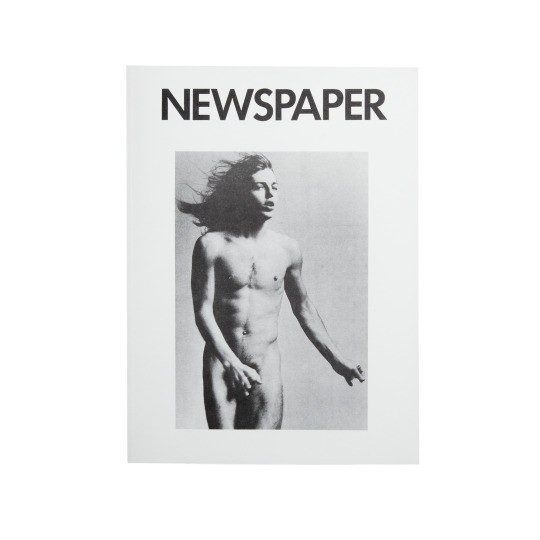


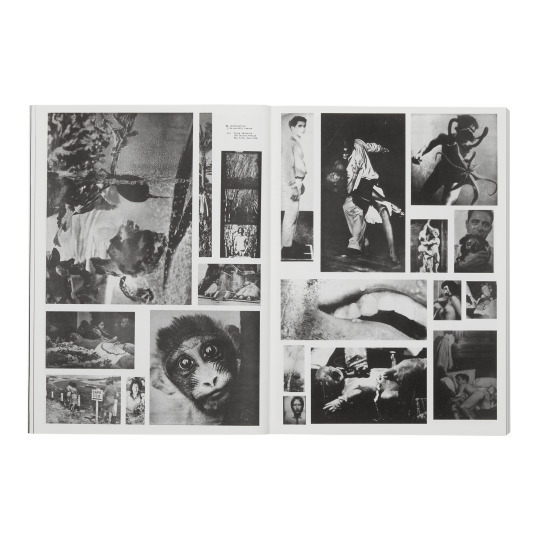

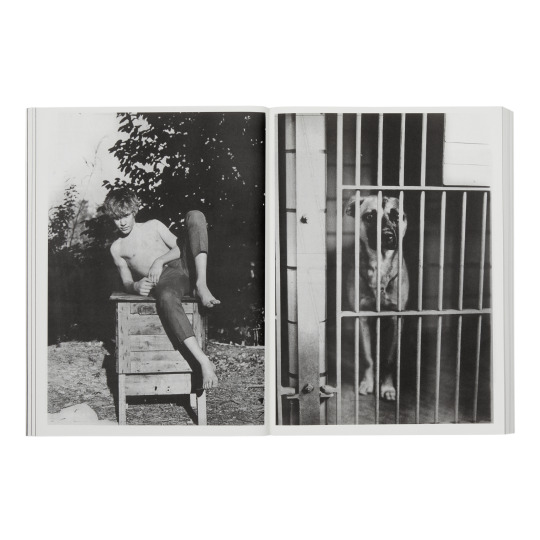
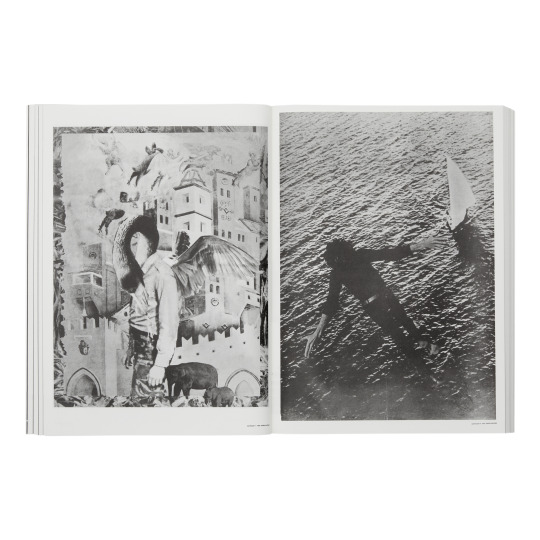


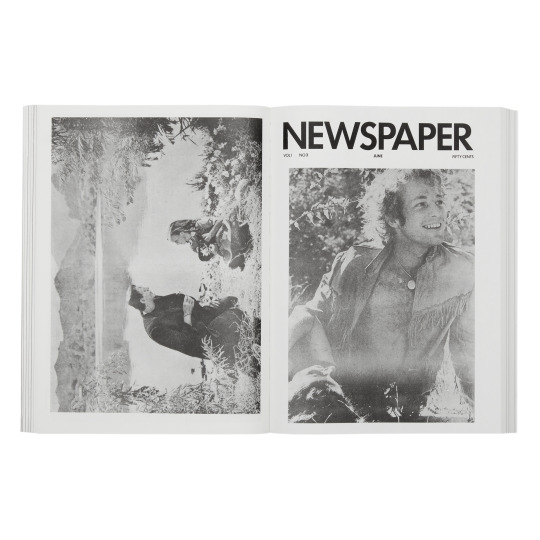

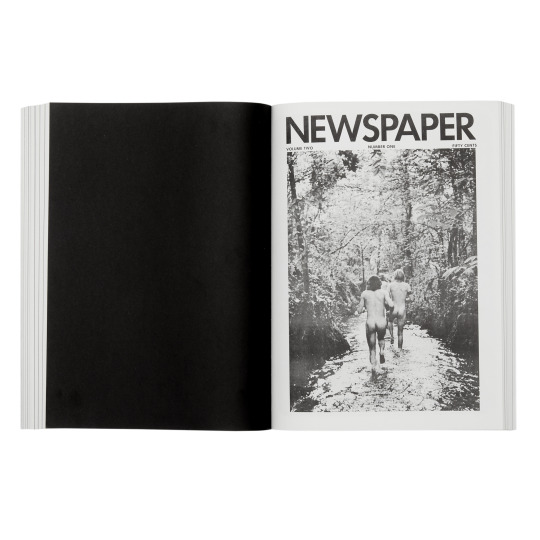
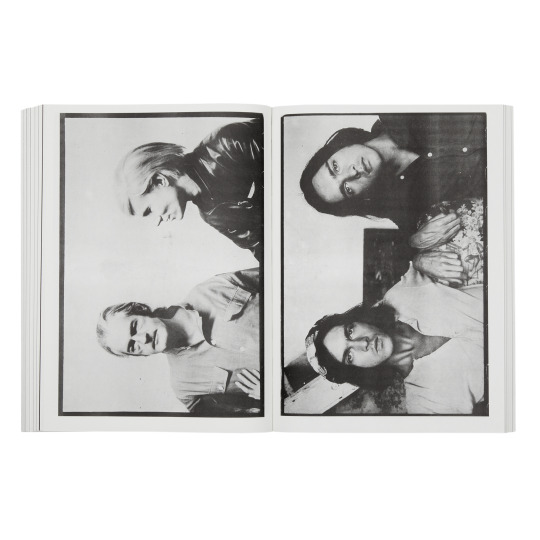
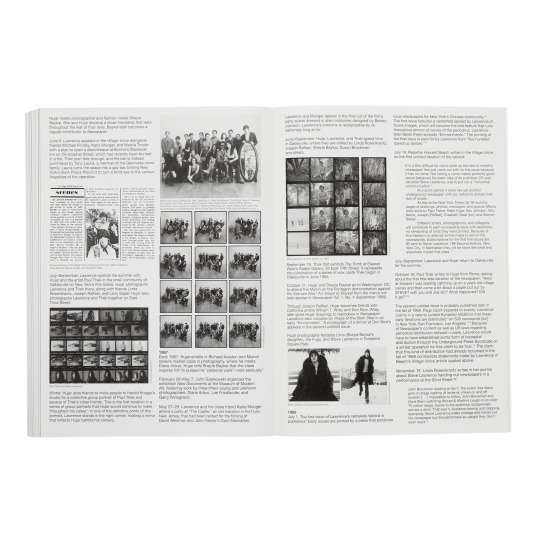
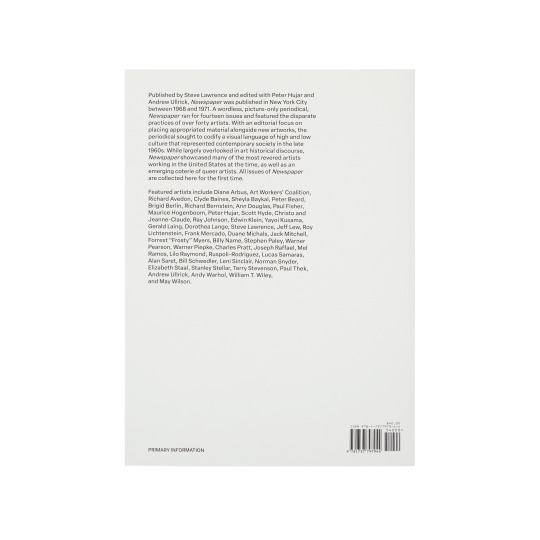
2023年9月15日
【新入荷・新本】
Various Artists Newspaper, Primary Information, 2023
416 pages. 9.75 x 13.38 Inches. Paperback. Edition of 4500.
価格:7,480円(税込)
/
1968年から1971年にかけてスティーヴ・ローレンスが発行し、ピーター・ヒュージャーとアンドリュー・ウルリックが編集に携わったニューヨーク発のタブロイド誌『Newspaper』の復刻版。
『Newspaper』は、言葉を使わず、写真だけを掲載した定期刊行物で、14号にわたって40人以上のアーティストの異質な活動を取り上げています。新しい作品と並行して流用された素材を掲載することに編集の重点を置き、1960年代後半の現代社会を象徴するハイカルチャーとローカルチャーの視覚的言語を体系化しようとしました。美術史的な言説からはほとんど見落とされているが、当時のアメリカで活躍し、尊敬されていた多数のアーティストと、新興のクィア・アーティストの仲間たちを紹介しています。
『Newspaper』は、1969年に創刊されたアンディ・ウォーホルの『Interview』や、レス・レヴィンの『Culture Hero』に先駆けるアーティストが発行するタブロイド誌のひとつですが、他のタブロイド紙とは対照的に、『Newspaper』はイメージに特化していました。
その全14号が初めてこの一冊にまとめられています。
Published by Steve Lawrence and edited with Peter Hujar and Andrew Ullrick, Newspaper was published in New York City between 1968 and 1971.
Newspaper was a wordless, picture-only periodical thatran for fourteen issues and featured the disparate practices of over forty artists. With an editorial focus on placing appropriated material alongside new works, the periodical sought to codify a visual language of high and low culture that represented contemporary society in the late 1960s. While largely overlooked in art-historical discourse, Newspaper showcased many of the most revered artists working in the United States at the time, as well as an emerging coterie of queer artists.
The mid to late sixties was a flourishing period for artists experimenting with new media formats such as books, records, and magazines to create or distribute their work. Newspaper was one of the first artist-published tabloids of its era, preceding Andy Warhol’s Interview and Les Levine’s Culture Hero, both of which debuted in 1969. However, in contrast to other tabloids, Newspaper focused strictly on images.
At a time when photography was not being exhibited regularly in galleries, Newspaper provided an alternative exhibition space for the medium and some of the era’s greatest photographers. The publication’s large size and unbound format encouraged readers to take it apart and hang its pages, which was how Newspaper was installed at the Museum of Modern Art’s influential Information show in 1970.
This is not to say that Newspaper only existed within the narrow confines of the art world, far from it. It lived within (and shared contributors with) a robust network of underground and queer periodicals like The New York Review of Sex, Rags, and Gay Power, among others. Yet, unlike many of these tabloids, Newspaper has largely disappeared from the discourse around underground magazines, queer publishing, and artists’ periodicals.
All fourteen issues of Newspaper are compiled in this volume for the first time.
Featured artists include: Diane Arbus, Art Workers Coalition, Richard Avedon, Clyde Baines, Sheyla Baykal, Peter Beard, Brigid Berlin, Richard Bernstein, Ann Douglas, Paul Fisher, Maurice Hogenboom, Peter Hujar, Scott Hyde, Christo and Jeanne-Claude Javacheff, Ray Johnson, Edwin Klein, Yayoi Kusama, Gerald Laing, Dorothea Lange, Steve Lawrence, Jeff Lew, Roy Lichtenstein, Frank Mercado, Duane Michals, Jack Mitchell, Forrest “Frosty” Myers, Billy Name, Stephen Paley, Warner Pearson, Jurgen Warner Piepke, Charles Pratt, Joseph Raffael, Mel Ramos, Lilo Raymond, Ruspoli-Rodriguez, Lucas Samaras, Alan Saret, Bill Schwedler, Leni Sinclair, Norman Snyder, Elizabeth Staal, Stanley Stellar, Terry Stevenson, Paul Thek, Andrew Ullrick, Andy Warhol, William T. Wiley, and May Wilson.
15 notes
·
View notes
Text
#December 2, 2023 #interview #Red Sea International Film Festival for #Jeanne Du Barry
Johnny talks about #Captain Jack Sparrow
3 notes
·
View notes
Text
Fate Actor AU
I am literally on a roll with these xD. Like these ideas keep popping up every time.
- This show was also produced and directed by Jonathan Joestar. Yeah Jonathan is the King of anime shows xD.
- This show has the most culturally diverse cast
- Gilgamesh is actually Turkish, well part Turkish part Iranian. He was born and raised in Istanbul and he and Eren Jaeger were best friends and neighbours since childhood
- They both promised each other that no matter what they would both make it in the entertainment industry and be successful and famous. Their wish came true years later and the two of them always talk about it in interviews
- Altoria is actually British like her character, Iskandar is from Greece, Lancelot is American, Hercules is actually South American, Medusa is from France, Emiya is Japanese but was raised in Italy, Cu is from Denmark, Diarmuid is also Dannish, Gilles is from France, The Hassans are all from Saudi Arabia, Medea is from Greece. Enkidu is Turkish as well
- Everyone speaks their national language at times and they kind of understand each other
- Everyone agrees that Kirei is the worst cook whilst Emiya is the best
- Gilgamesh is different from his character in the sense that he is an actual chill dude though he can be tsundere xD
- He got tummy aches from the laughs
- Speaking of the laughs, he did several takes because he just could not stop laughing and that is because Altoria always says something to make him laugh
- He respects Altoria a lot and is protective of her much to everyone’s amusement
- Altoria likes Gilgamesh and teases him a lot
- The gang always swap stories about their upbringing and whatnot
- Everyone is protective of the younger Masters like Ritsuka, Tine and Hakuno
- Kirei and Gilgamesh often play chess on set and often ask Tokiomi to hang with them
- Rin is Tokiomi’s real life daughter plus she plays both Ishtar and Ereshkigal plus herself
- Her bickering with Gilgamesh when in Ishtar mode makes everyone laugh
- Sakura plays a handful of characters as well as Shirou
- There was a character so many Turks requested for for years to be added to Fate Grand Order- Sultan Mehmed the Conqueror
- Jonathan always wanted to add this character but could not think of someone to play this character until Gilgamesh suggested one name: Eren Jaeger
- Jonathan was skeptical at first till he saw Eren did a reading for him. Plus seeing Eren in full costume complete with the signature turban and giving off some Gilgamesh-esque vibes helped
- Eren loved playing his character and thanked Gilgamesh for helping him land the role
- The segments involving the Sultan and Gilgamesh were considered hilarious as the dynamic between those two is similar to the one Gilgamesh has with Ozymandias and Iskandar. Only difference is that these two always bicker xD.
- Eren’s signature Mehmed laugh is similar to Gilgamesh’s laugh and he too got tummy aches from excessive laughter xD
- Ozy is a proud Egyptian and gave the casta t our of Egypt alongside the Egyptian servants
-Nitocris always gets nervous whenever she shoots a scene
- Cleopatra once got severe burns on set thanks to some skincare product she bought and had to be taken to the hospital for treatment
- Caesar eats a lot and Cleo worries about his health
- Speaking of Ozymandias and Iskandar, the both of them plus Arthur, Eren and Gilgamesh hang out off-set and often get into prank wars on set with Jeanne Alter, Altoria, Ushiwakamaru, Rin and Sakura
-Jeanne and Jeanne Alter are twins
- Nursery Rhyme and Jack the Ripper always play outside with the other kids from other sets
- Gilgamesh wishes to settle down soon. Altoria always nags him to go get a girlfriend and she and Enkidu have tried setting up blind dates for him. Truth is Gilgamesh is in love with someone and it is not Enkidu or Altoria or even Ozymandias as many suspect. People suspect Eren because one story about them getting it on onset. Both have neither denied nor confirmed it.
- Hercules is such a gentle giant and everyone loves and cares for him, plus he talks normally
- All the Roman servants often annoy the Turks on set who chase after them every time
- Nero always gives everyone chocolate every single Valentine’s Day
- Elizabeth is an actual good singer and was confused as to how to sing badly for her character
- Camille and the vampiric servants drink wine a lot and often invite Dio over for a chat
- The Jojo set is close to the Fate set so the Jojo cast often visits
- The younger servants love playing hide and seek on set and also tag. The young Jojo kids join in the fun.
- One of the highlights every evening is that everyone from the Jojo, Fate and other related sets come out and sit by a bonfire and start talking about life. The older folks give the younger ones advice.
- Snowball fights ahoy
- Everyone calls Jonathan either Jojo or dad
- There was a lot of fight and stunt training for the entire cast, something they all enjoyed
- Gilgamesh likes the whole concept of the show which was why he agreed to it in the first place
- Medea always forgets her lines
- Illya likes messing with Hercules’s hair
- Everyone plays the different versions of themselves
- Ashiya Douman is the resident troll on set
- Gilgamesh did not like the armour at first due to how bulky it was but he soon got used to it and ended up liking it
#gilgamesh#attack on titan#eren jaeger#shingeki no kyojin#fate#fate grand order#iskandar#ozymandias#altoria pendragon#rin tohsaka#kirei kotomine#tokiomi tohsaka#sakura#shirou emiya#medea
9 notes
·
View notes
Text
Casting variations
One of the things that I'm really fascinated with is the casting solutions that happen sort of quietly to keep the production running when there's a vacancy for whatever reason (like, say, one of the main cast members CUTTING OFF A BIT OF THEIR FINGER IN A DOOR 😱😱😱)
So while Adrien Fruit is off (for how long? poor bb) I assume his understudy Nic Dorian will be playing Ziggy, and it looks like William Cloutier has been recruited to fill Nic Dorian's part as one of Janvier's assistants (as per Ambriel's rehearsal video from this afternoon.)

(I have actually never asked myself if Adrien is the one who fills this role when Nic Dorian is playing Ziggy -- is it usually William? If anyone happens to know plz fill me in lol)
Obviously this then raises the question of what happens if Adrien is still off by Saturday afternoon, when William will be busy doing Johnny!
But it's not the first time there has been a need to fill someone's shoes.
Stella's maid, for example, has been played by at least 3 people that I know of. Usually it's Jeanne Jerosme, but when Jeanne is having her turn as Stella, I don't think Maag does the maid. I've seen Jeanne as Stella twice; the second time it was Alice Nguyen as the maid, and the first time, I was surprised to find out from my pictures that it was actually Gabrielle Lapointe!

Zéro Janvier's bodyguard (who doesn't sing but has a significant comical miming part during "Ego Trip") has also been played by an understudy's understudy. It's usually Aurel Fabrègues (David Latulippe's understudy) and David when Aurel is playing the main role, but when David Latulippe was fully out of commission for a bit the role was filled by the assistant directior, Samy Zerrouki-Recroix (who they'd apparently dubbed "Un Février" lol)
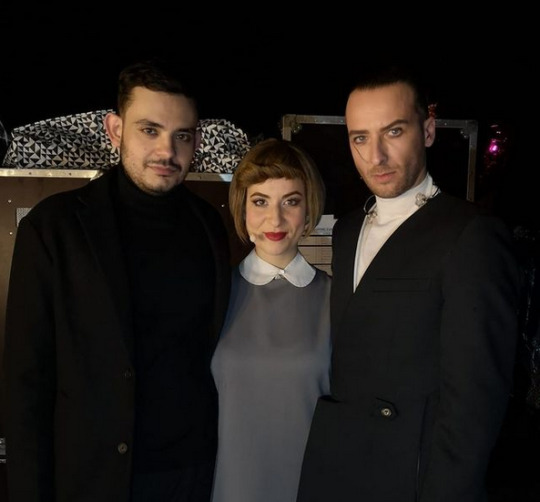
The camera person from "Interview de Johnny Rockfort" has also been done by various people, usually dancers I believe - it was Hajiba Fahmy for a bit, then someone else. Last time we were there Gabrielle Lapointe (jack of all trades!) was the one doing it, which is a pretty big job because the footage shown on the big screen is live so the camera movements have to be super precise (although deliberately shaky, which probably helps lol.)
There are also funny things happening during the orgy "Procession du Gourou" bit, where the people dancing aren't always who you'd expect...
Anyway! This is the kind of niche dumb details I love to collect!!
(Get well soon Adrien 💀💀💀)
#starmania 2022#behind the scenes#adrien fruit#william cloutier#jeanne jerosme#gabrielle lapointe#Casting news#adventures in casting#the maid#alice nguyen
7 notes
·
View notes
Text
Episode 160: Biographical Fiction & Fictional Biographies
This episode we’re talking about Biographical Fiction & Fictional Biographies! We talk about metafiction, superhero origins as cover songs, spaceship detectives, cat biographies, amendments to amendments, alien abductions, and more!
You can download the podcast directly, find it on Libsyn, or get it through Apple Podcasts, Stitcher, Google Podcasts, or your favourite podcast delivery system.
In this episode
Anna Ferri | Meghan Whyte | Matthew Murray | Jam Edwards
Things We Read (or tried to…)
Nat Tate: An American Artist: 1928-1960 by William Boyd
Wikipedia
Maigret's Memoirs by Georges Simenon, translated by Howard Curtis
Matthew was wrong about how many books in this series came out in one month, but based on the French Wikipedia article four titles (including this one) were released in 1951.
Confessions of the Fox by Jordy Rosenberg
Jack Sheppard (Wikipedia)
The Dreamer by Pam Muñoz Ryan and Peter Sís
Orlando: A Biography by Virginia Woolf (Wikipedia)
Summertime by J.M. Coetzee
Other Media We Mentioned
Oscar Wilde Murder Mysteries Series by Gyles Brandreth
Girl with a Pearl Earring by Tracy Chevalier
Wolf Hall by Hilary Mantel
Doc Savage: His Apocalyptic Life by Philip José Farmer
What Is the What by Dave Eggers
Moll Flanders by Daniel Defoe (Wikipedia)
Blonde (2022 film) (Wikipedia)
Blonde by Joyce Carol Oates
Smile (2022 film) (Wikipedia)
Bastard Out of Carolina by Dorothy Allison
The Limits of Autobiography: Trauma, Testimony, Theory by Leigh Gilmore
The Sot-Weed Factor by John Barth
The Red Tent by Anita Diamant
Summer Fun by Jeanne Thornton
Mrs Dalloway by Virginia Woolf (Wikipedia)
A Field Guide to the Aliens of Star Trek: The Next Generation by Joshua Chapman (zine series)
We can’t find a good link for the zines, but it’s been collected as a book
Interview with the Vampire (film) (Wikipedia)
A Canticle for Leibowitz by Walter M. Miller Jr.
The Big Lebowski (Wikipedia)
Lamb: The Gospel According to Biff, Christ's Childhood Pal by Christopher Moore
Links, Articles, and Things
Episode 143 - Amish Romance
Episode 119 - Regence Romance
Episode 094 - Chick Lit Romance
Episode 070 - Erotic Romance
The 7 Best Library Podcasts
Fictionalized biography (Encyclopædia Britannica)
Autofiction (Wikipedia)
Isekai (Wikipedia)
Oliver Cromwell (Wikipedia)
Epistolary novel (Wikipedia)
Episode 111 - Happy Birthday Dracula
Episode 128 - Plucky Kid Detective
Episode 136 - Hearts of Magic: Threads Entangled
List of biblical figures identified in extra-biblical sources (Wikipedia)
List of Dewey Decimal classes (Wikipedia)
National Library of Medicine classification (Wikipedia)
Zaphod Beeblebrox (Wikipedia)
“Vell, Zaphod’s just zis guy, you know?”
False memory: Mandela Effect (Wikipedia)
17 Fictional Biographies books by BIPOC (Black, Indigenous, & People of Colour) Authors
Every month Book Club for Masochists: A Readers’ Advisory Podcasts chooses a genre at random and we read and discuss books from that genre. We also put together book lists for each episode/genre that feature works by BIPOC (Black, Indigenous, & People of Colour) authors. All of the lists can be found here.
Carolina Built by Kianna Alexander
Clotel: or, The President's Daughter by William Wells Brown
Pocahontas by Joseph Bruchac
American Woman by Susan Choi
The Black Rose by Tananarive Due
The Reason for Crows: A Story of Kateri Tekakwitha by Diane Glancy
Stone Heart: A Novel of Sacajawea by Diane Glancy
Driving the King by Ravi Howard
Delayed Rays of a Star by Amanda Lee Koe
Leo Africanus by Amin Maalouf, translated by Peter Sluglett
Empress Orchid by Anchee Min
Dancing in the Dark by Caryl Phillips
Douglass' Women by Jewell Parker Rhodes
I the Supreme by Augusto Roa Bastos, translated by Helen Lane
Empress by Shan Sa
The Book of Salt by Monique Truong
Black Cloud Rising by David Wright Faladé
Give us feedback!
Fill out the form to ask for a recommendation or suggest a genre or title for us to read!
Check out our Tumblr, follow us on Twitter or Instagram, join our Facebook Group, or send us an email!
Join us again on Tuesday, October 18th for our SpoooooOOOoooky Halloween episode we’ll be talking about the concept of Hate Reads!
Then on Tuesday, November 1st we’ll be discussing the genre of Investigative Journalism!
6 notes
·
View notes
Note
I'm not an anti I swear but I'm really starting to think her and Joe broke up. I mean it's all so fucking weird. She hasn't liked his last two posts (her friends haven't either), she's in New York doing God knows what when she could've gone to Cannes with him since it's such a big deal. I mean Jack took Saoirse. Austin took Kaya. Jake took Jeanne even though the event wasn't even focused on him. I saw Alicia Vikander took Michael Fassbender too. Like there were SO MANY COUPLES there this year, even those who are hermits as we know like jackoirse. Also he refuses to speak about her in interviews and is just acting weird as fuck. There's this new interview joealwyndaily shared, everyone is sharing little anecdotes about their partners and Joe looks really uncomfortable. Also he isn't wearing the watch anymore. He wasn't wearing it in any of his latest events and he wore a new Chopard one to the premiere. One could argue about the flight LA > NY but that could've been ANYONE. LA is a huge ass place and I'm sure Joe wasn't the only person she knows who was there at the time. It's looking real weird, dude.
He’s wearing a Chopard watch because he was sponsored by them dude he said so to W, Taylor Swift /=/ Saoirse Ronan and it’s much harder for her to do shit, Taylor is working (you want her to do that right???), and Joe can’t talk about his partner because she’s Taylor Swift and that will be THE ONLY PULL QUOTE that ANYONE will run.
Idk how to drive this home lmao like his life isn’t normal and they’re NOT like other couples when it comes to media. They won’t be until she is no longer #1 and even then it’ll always be a bit weird.
Re Insta she LITERALLY DOES NOT KNOW WHEN HE POSTS if they’re not together. She posted the CWF story in between these two posts bestie so like was publicly supporting the show.
Like take a deep breath, you’ve made this shit up tbh.
3 notes
·
View notes
Text
Price: [price_with_discount]
(as of [price_update_date] - Details)
[ad_1]
Beginning early in the 1980s, a dance music revolution swept across Europe and Britain, merging rock, new wave, disco and worldbeat sounds. The resulting explosion of high-energy, increasingly electronic dance-pop caused a sensation worldwide.
In this book of original English language interviews, 32 of the era's most celebrated artists, producers and industry professionals discuss their lives and careers: Thomas Anders (Modern Talking's "You're My Heart, You're My Soul"), Pete Burns (Dead or Alive's "You Spin Me Round (Like a Record)"), Desireless ("Voyage Voyage"), Phil Harding (PWL Mixmaster), Junior ("Mama Used to Say"), Leee John (Imagination's "Just an Illusion"), Liz Mitchell (Boney M.'s 1988 "Megamix"), Fab Morvan (Milli Vanilli's "Girl You Know It's True"), Taco ("Putting On the Ritz"), Jennifer Rush ("The Power of Love"), Sabrina ("Boys"), Spagna ("Call Me"), Amii Stewart ("Knock on Wood"), Yazz ("The Only Way Is Up") and many more.
Includes special commentary by Academy Award winner Mel Brooks and Audrey Landers, star of Dallas. FULL LIST OF ARTISTS FEATURED: Foreword by Mel Brooks
Foreword by Audrey Landers
Thomas Anders, Modern Talking
Jo Bogaert, Technotronic
Pete Burns, Dead or Alive
Phil Creswick, Big Fun
Hazell Dean
Manfred Esser, photographer of Modern Talking, Fancy
Claudie Fritsch aka Desireless
Junior Giscombe aka Junior
Jaki Graham
Phil Harding, PWL Mixmaster
Klaus Hirschburger, songwriter for Sandra
Tom Hooker
Leee John, Imagination
Carmelo La Bionda, producer, composer
Caroline Loeb
Paul Mazzolini aka Gazebo
Liz Mitchell, Boney M.
Fab Morvan, Milli Vanilli
Romano Musumarra, producer, composer for Jeanne Mas, Stephanie
Taco Ockerse aka Taco
Linda Jo Rizzo
Jack Robinson, songwriter for Gloria Gaynor, Grace Jones, Tina Charles
Fabio Roscioli aka Ryan Paris
Jennifer Rush
Sabrina Salerno aka Sabrina
Ivana Spagna aka Spagna
Amii Stewart
Ric Tess Teiges aka Fancy
Harriette Weels, MaiTai
Yasmin Evans aka Yazz Other books in this dance music series:First Ladies of DiscoLegends of DiscoEurope's Stars of 80s Dance Pop Vol. 2Stars of 90s Dance PopStars of 21st Century Dance Pop & EDM
[ad_2]
0 notes
Text
Things Read in February
Essays & Articles:
The Battle for the Heart of the Great American Nudie Suit
"We Will Always Have the Nightmares"
A California redwood forest has officially been returned to a group of Native tribes
On the Lie of "Let People Like Things"
The Case Against the Trauma Plot
The Joe Rogan Controversy Has a Deeper Cause
Is 2000s Tech the Next Big Fashion Aesthetic?
We Owe Courtney Stodden An Apology
'The Rise and Fall of LuLaRoe' Investigates Scandal Behind Marketing Company
Matilda Bernstein Sycamore on Writing on Your Own Terms
The mythical genius of Daidalos, the first polymath
Horror Fiction in the Age of Covid
Love bombing, gaslighting, and the problem with pathologising dating talk
How to Have Closer Friendships (and Why You Need Them)
How this jellyfish earned the nickname 'Psychadelic Medusa'
Herodotus' Other Lies
Is it a clash over writing...
France's nuclear colonial legacy in Algeria
"My pink socialism became red as a wound": Impossible interview from Ukraine
My Body is Used to Design Military Tech
10 Questions You Should Never Be Asked in a Job Interview
Stop Pretending the Left is on Putin's Side
The American Boy
Millennial Women Made LuLaRoe Millions. Then They Paid the Price.
Mary Renault: how classical Greece reflected her troubled life
i: vision
Poetry:
Do You Wonder About All The Black Girls Speckling That Beach by Salt
February by Jack Collom
Arguing with Something Plato Said by Jack Collom
Invocation by Cid Corman
Ariadne by Jeanne Murray Walker
Worm Moon by Mary Oliver
Helen of Troy Does Countertop Dancing by Margaret Atwood
The Horse Fell Off the Poem by Mahmoud Darwish
The Summer A Tribe Called Quest Broke Up by Hanif Abdurraqib
Theseus Within the Labyrinth by Stephen Dobyns
Books:
Ariadne by F. L. Lucas
The King Must Die by Mary Renault
Los Reyes by Julio Cortázar, translated by Juan Sebastian de Vivo
The Perks of Being A Wallflower by Stephen Chbosky
The Dark Tower and Other Stories by C. S. Lewis
Theseus by Plutarch
#tcp#articles#an open window#poetry#u can tell i had ariadne theseus the labyrinth the minotaur on the mind this month lol#essays#forgot to add the last 2 oops
1K notes
·
View notes
Text
ZIEGFELD FOLLIES
April 8, 1946
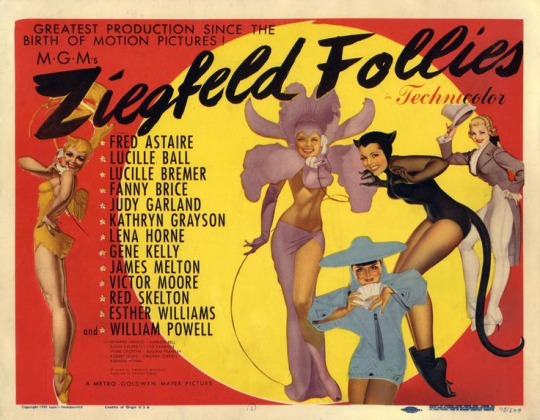
Directors: Lemuel Ayers, Roy Del Ruth. Vincente Minnelli, George Sidney,
Norman Taurog, Charles Walters. Robert Lewis
Producer: Arthur Freed for Metro Goldwyn Mayer
The shooting schedule ran between April 10 and August 18, 1944, with retakes plus additional segments filmed on December 22, 1944 and then between January 25 and February 6, 1945. The film was first proposed in 1939.
Synopsis ~ We meet a grayed, immaculately garbed Florenz Ziegfeld, Jr. in Paradise (his diary entry reads "Another heavenly day"), where he looks down upon the world and muses over the sort of show he'd be putting on were he still alive.
PRINCIPAL CAST

Lucille Ball ('Here's to the Ladies') is appearing in her 64th film since coming to Hollywood in 1933.
Fred Astaire ('Here's to the Ladies' / Raffles in 'This Heart of Mine' / Tai Long in 'Limehouse Blues’ / Gentleman in 'The Babbit and the Bromide') also appeared with Lucille Ball in Roberta (1935), Top Hat (1935), and Follow the Fleet (1936). His name was mentioned twice on “I Love Lucy.”
Lucille Bremer (Princess in 'This Heart of Mine' / Moy Ling in 'Limehouse Blues')
Fanny Brice (Norma Edelman in 'A Sweepstakes Ticket') appeared in the original stage version of many editions of The Ziegfeld Follies on Broadway.
Judy Garland (The Star in 'A Great Lady Has An Interview') also starred with Lucille Ball in Thousands Cheer (1943).
Kathryn Grayson (Kathryn Grayson in 'Beauty') also starred with Lucille Ball in Thousands Cheer (1943).
Lena Horne (Lena Horne in 'Love') also starred with Lucille Ball in Thousands Cheer (1943).
Gene Kelly (Gentleman in 'The Babbit and the Bromide') also starred with Lucille Ball in Thousands Cheer (1943), Du Barry Was A Lady (1943), and A Guide for the Married Man (1967). He made an appearance on the Lucille Ball special “Lucy Moves to NBC” (1980).
James Melton (Alfredo in 'La Traviata')
Victor Moore (Lawyer's Client in 'Pay the Two Dollars')
Red Skelton (J. Newton Numbskull in 'When Television Comes') also starred with Lucille Ball in Having Wonderful Time (1938), Thousands Cheer (1943), Du Barry Was A Lady (1943), and The Fuller Brush Girl (1950). On TV he appeared on “The Lucy-Desi Comedy Hour” in “Lucy Goes To Alaska” (1958). Ball and Skelton appeared in numerous TV specials together.
Esther Williams (Esther Williams in 'A Water Ballet') also appeared with Lucille Ball in Easy To Wed (1946).
William Powell (Florenz Ziegfeld Jr.) also played the same character in The Great Ziegfeld (1936).
Edward Arnold (Lawyer in 'Pay the Two Dollars') appeared with Lucille Ball in Roman Scandals (1933) and Ellis in Freedomland (1952).
Marion Bell (Violetta in 'La Traviata')
Cyd Charisse (Ballerina in 'Beauty') also starred with Lucille Ball in Thousands Cheer (1943).
Hume Cronyn (Monty in 'A Sweepstakes Ticket') was honored by The Kennedy Center in 1986, at the same ceremony as Lucille Ball.
William Frawley (Martin in 'A Sweepstakes Ticket') played the role of Fred Mertz on “I Love Lucy” and “The Lucy-Desi Comedy Hour”. He also appeared on “The Lucy Show,” his final screen appearance.
Robert Lewis (Chinese Gentleman in 'Limehouse Blues' / Telephone Voice in 'Number Please')
Virginia O'Brien (Virginia O'Brien in 'Here's to the Ladies') also starred with Lucille Ball in Thousands Cheer (1943), Du Barry Was A Lady (1943), and Meet The People (1944).
Keenan Wynn (Caller in 'Number Please') appeared with Lucille Ball in Easy To Wed (1946), Without Love (1945), and The Long, Long Trailer (1954).
SUPPORTING CAST
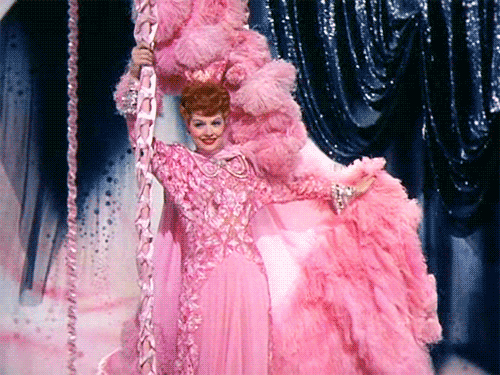
Ziegfeld Girls
Karin Booth
Lucille Casey
Aina Constant
Elizabeth Dailey
Frances Donelan
Natalie Draper
Karen X. Gaylord
Aileen Haley
Carol Haney
Shirlee Howard
Margaret Laurence
Helen O'Hara
Noreen Roth
Elaine Shepard
Kay Thompson
Dorothy Tuttle
Dorothy Van Nuys
Eve Whitney - appeared on “I Love Lucy” episode “The Charm School” (ILL S3;E15).
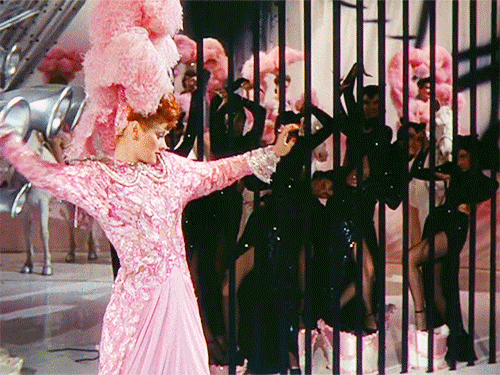
Dancers
Gloria Joy Arden
Jean Ashton
Irene Austin
Judi Blacque
Bonnie Barlowe
Norman Borine
Hazel Brooks
Ed Brown
Kathleen Cartmill
Jack Cavan
Marilyn Christine
Laura Corbay
Rita Dunn
Meredyth Durrell
Shawn Ferguson
Jeanne Francis
Jean French
Mary Jane French
David Gray
Bill Hawley
Doreen Hayward
Charlotte Hunter
Virginia Hunter
Patricia Jackson
Margaret Kays
Laura Knight
Laura Lane
Dale Lefler
Melvin Martin
Diane Meredith
Lorraine Miller
Joyce Murray
Janet Nevis
Ray Nyles
Billy O'Shay
Jane Ray
Dorothy Raye
Beth Renner
Melba Snowden
Walter Stane
Ivon Starr
Robert Trout
Chorus Boys
Rod Alexander
Milton Chisholm
Dick D'Arcy
Dante DiPaolo
Don Hulbert
Herb Lurie
Matt Mattox
Bert May - appeared on “The Lucy Show” in “Lucy and Tennessee Ernie Ford”
Jack Purcell
Tommy Rall
Ricky Ricardi (!)
Alex Romero
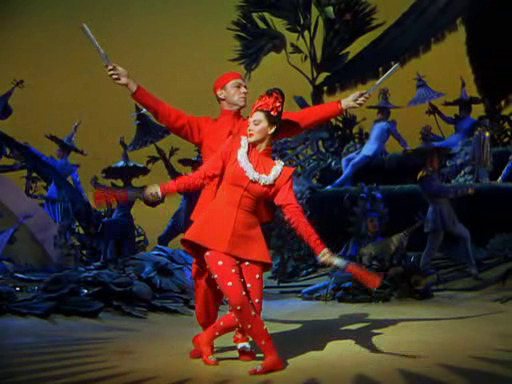
“LIMEHOUSE BLUES” starring Fred Astaire, Lucille Bremer, and Robert Lewis
Robert Ames (Masked Man)
James Barron (Couple with Banners)
Eleanor Bayley (Couple with Branches)
Mary Jo Ellis (Couple with Banners)
Sean Francis (Ensemble)
James King (Rooster)
Harriet Lee (Bar Singer)
Eugene Loring (Costermonger)
Charles Lunard (Masked Man)
Patricia Lynn (Ensemble)
Ruth Merman (Ensemble)
Garry Owen (1st Subway Policeman)
Ellen Ray (Couple with Parasols)
Jack Regas (Masked Man)
Billy Shead (Couple with Parasols)
Ronald Stanton (Couple with Branches)
Wanda Stevenson (Ensemble)
Ray Teal (2nd Subway Policeman)

“LOVE” starring Lena Horne
Juliette Ball (Club Patron)
Lennie Bluett (Dancer)
Suzette Harbin (Flirt)
Avanelle Harris (Club Patron)
Maggie Hathaway (Dancer)
Charles Hawkins (Club Patron)
Marie Bryant (Woman Getting Her Man Taken)
Cleo Herndon (Dancer)

“THIS HEART OF MINE” starring Fred Astaire and Lucille Bremer
Helen Boyce (Countess)
Feodor Chaliapin Jr. (Lieutenant)
Naomi Childers (Duchess)
Charles Coleman (Majordomo)
Sam Flint (Majordomo's Assistant)
Sidney Gordon (Masked Man)
Count Stefenelli (Count)
Robert Wayne (Dyseptic)

“PAY THE TWO DOLLARS” starring Edward Arnold and Victor Moore
William Bailey (Subway Passenger)
Joseph Crehan (1st Judge) - played a Detective on “I Love Lucy” “The Great Train Robbery”
William B. Davidson (2nd Judge)
Eddie Dunn (3rd Subway Policeman)
Harry Hayden (Warden)
George Hill (2nd Subway Policeman)
Wilbur Mack (Subway Passenger)
Larry Steers (Magistrate)
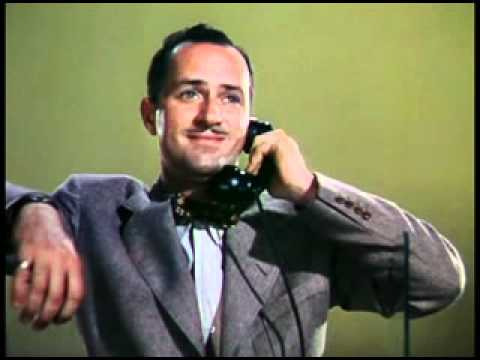
“NUMBER PLEASE” starring Keenan Wynn
Peter Lawford (Voice of Porky)
Grady Sutton (Texan)
Audrey Totter (Phone Operator Voice)
Kay Williams (Girl)
OTHERS
Bunin's Puppets
Elise Cavanna (Tall Woman)
Jack Deery (Man)
Rex Evans (Butler in "A Great Lady Has An Interview”)
Sam Garrett (Roping / Twirling Act)
Silver (Horse in "Here's to the Ladies')
Arthur Walsh (Telegraph Boy in "A Sweepstakes Ticket") - appeared on “I Love Lucy” in “Lucy Has Her Eyes Examined” (ILL S3;E11).
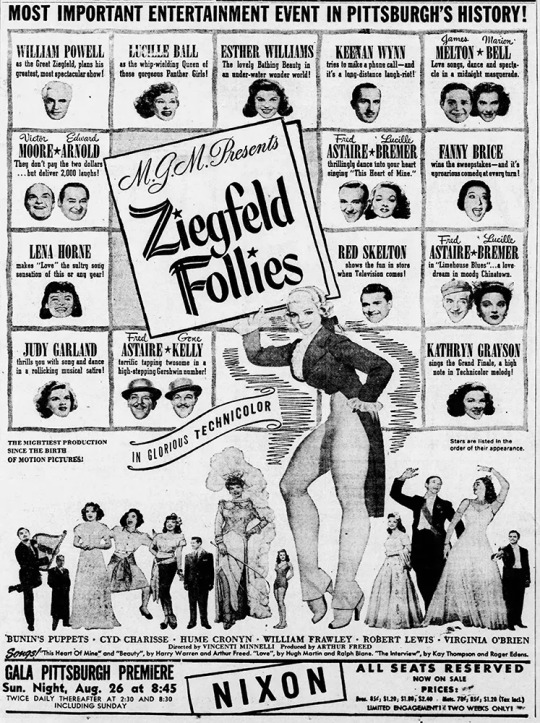
‘FOLLIES’ TRIVIA
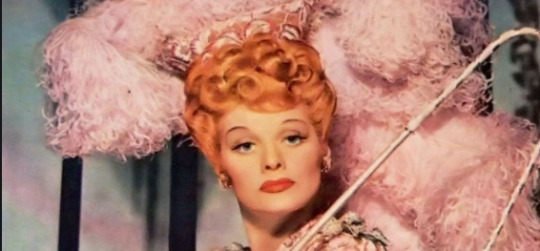
Sidney Guilaroff, Lucille Ball’s hair dresser, who takes responsibility for her famous ‘golden red’ for this movie, becoming her trademark color.
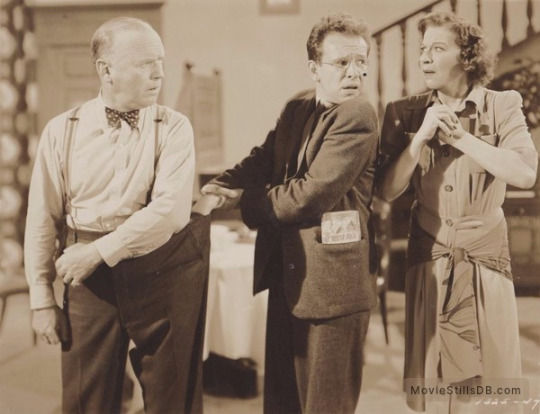
Although they appear in different segments, this is the only feature film collaboration between “I Love Lucy co-stars" Lucille Ball and William Frawley. Coincidently, Frawley's character in this film shares a striking similarity with his iconic character of Fred Mertz on “I Love Lucy.” In this film he plays a money-hungry curmudgeon of a landlord, much like the show. In the above photo, he appears with director Minnelli and co-star Brice.

The horse ridden by Lucille Ball is the Lone Ranger's Silver!
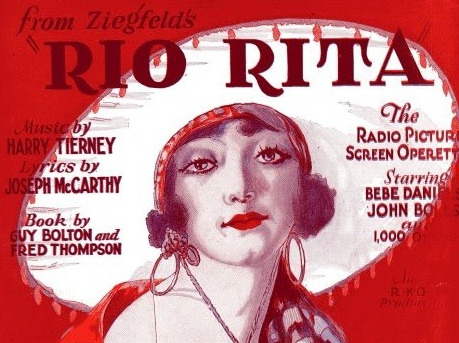
Lucille Ball was actually fired by Ziegfeld from his road company production of Rio Rita in the 1930s.

In February 1956, Lucy and Desi appeared on “MGM Parade” to promote their MGM film Forever Darling. The show also included footage of Lena Horne singing from Ziegfeld Follies.
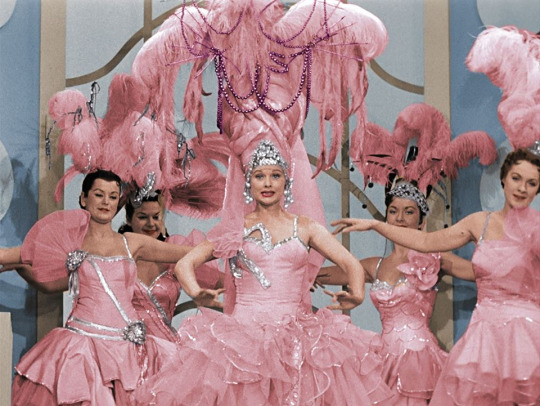
Lucy also played a showgirl in pink in “Lucy Gets Into Pictures” (ILL S4;E19) aired on February 21, 1955. The scene was inspired by Ziegfeld’s legendary stage shows featuring beautiful women wearing elaborate costumes navigating long staircases. To solidify the comparison, Ricky says he is going to a meeting with Mr. Minnelli. Vincente Minnelli was one of the directors of Ziegfeld Follies.

Lucy Ricardo had previously cavorted around in a lampshade in the manner of a Ziegfeld girl in both the unaired pilot and “The Audition” (S1;E6).

Ziegfeld Follies includes a sketch for Red Skelton called “When Television Comes” aka “Guzzler’s Gin” in which a (future) television spokesman gets increasingly sloshed on his product. This sketch was an obvious influence on Lucy’s Vitameatavegamin routine in “Lucy Does a TV Commercial” (ILL S1;E30) aired on May 5, 1952.

Ziegfeld Girl Eve Whitney appeared on “I Love Lucy” episode “The Charm School” (ILL S3;E15). She used her own name for the character.
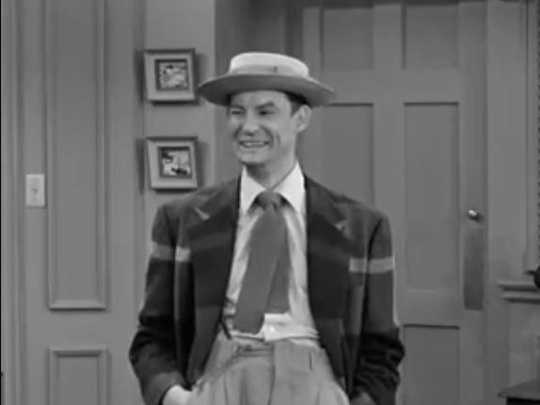
The Telegraph Boy in "A Sweepstakes Ticket" Arthur Walsh - appeared on “I Love Lucy” in “Lucy Has Her Eyes Examined” (ILL S3;E11) as Arthur ‘King Cat’ Walsh. He teaches Lucy how to jitterbug.
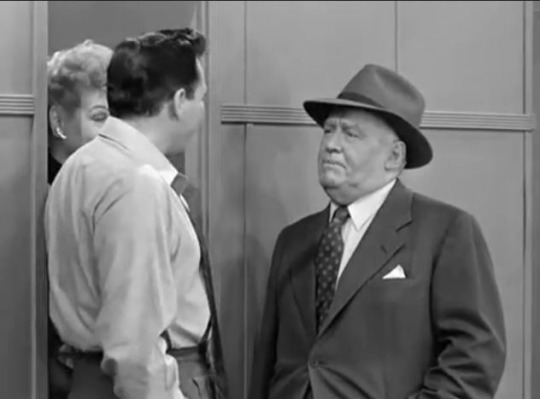
The first Judge in the “Pay the Two Dollars” James Crehan also played the Police Detective on “I Love Lucy in “The Great Train Robbery” (ILL S5;E5) first aired on October 31, 1955.

Porky, a voice on the telephone in “Number Please” Peter Lawford, played “Password” against Lucille Ball on September 24, 1964. At the time, Lawford was married to President Kennedy’s sister, Patricia. On November 26, 1968, Ball was a guest on “The Tonight Show” when Peter Lawford was sitting in for Johnny Carson.
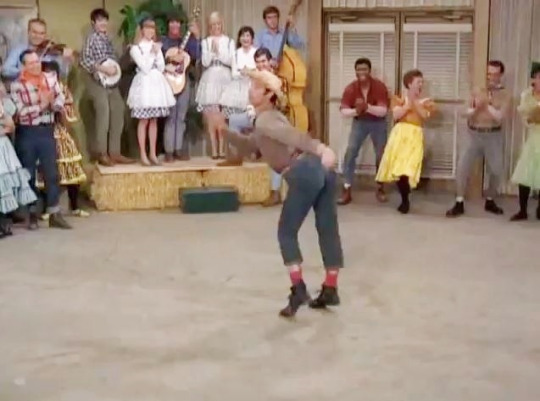
Chorus Boy Bert May appeared as a solo dancer on “The Lucy Show” in “Lucy and Tennessee Ernie Ford” (TLS S5;E21) in February 1967.

In the dressing room, Lucy jokes with Fanny Brice, one of the funniest women in showbusiness. This was the only time Ball and Brice collaborated and was Brice’s last film.

Ziegfeld’s follies began on Broadway, so it was appropriate that the show featured past and future Broadway musical stars:
Lucille Ball ~ Wildcat (1960)
Carol Haney ~ The Pajama Game (1954)
Tommy Rall ~ Call Me Madame (1950)
Fanny Brice ~ The Ziegfeld Follies
Marion Bell ~ Brigadoon (1947)
Victor Moore ~ Anything Goes (1934)
There was a lot of material that was not filmed, but written and cast. Some of the original skits would have added “Lucy” performers Mickey Rooney, Ann Sothern, and Van Johnson to the cast.
#Ziegfeld Follies#Lucille Ball#Florenz Ziegfeld#1946#MGM#Fanny Brice#Fred Astaire#William Frawley#Arthur Walsh#Eve Whitney#Bert May#peter lawford#James Crehan#I love lucy#Red Skelton#Keenan Wynn#Gene Kelly#Judy Garland#Esther Williams#Lucille Bremer#Lena Horne#Vincente Minnelli#William Powell#Cyd Charisse
61 notes
·
View notes
Text
Jack Jeanne Complete Collection - Interview with Terasaki Yuka (Kisa’s Voice Actor) Translation
This short cast interview is from the Jack Jeanne Complete Collection art book!
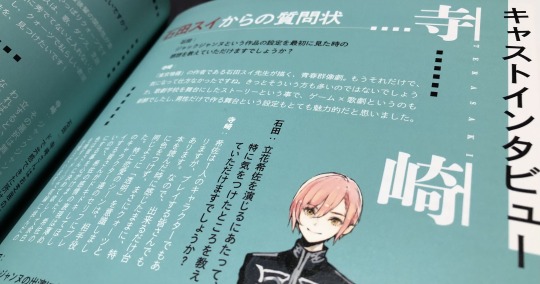
Ishida: What were your impressions when you first saw the setting of Jack Jeanne?
Terasaki: It’s a story about teenagers putting on plays together that’s drawn by the creator of Tokyo Ghoul, Ishida Sui-sensei. That information alone was all it took for me to be interested. I’m sure a lot of other people thought the same.
Since it’s a story that takes place in a theatre school, I found the way it's like a game meets theatre to be unique. I also found the aspect that the shows are put on by an all male cast to be really intriguing.
—
Ishida: When you were voicing Tachibana Kisa, were there any aspects of your performance that you had to be careful about?
Terasaki: Kisa is a character herself, but she is also the stand in for everyone that’s playing the game. That’s why I stuck to the initial impression of the script as much as possible without adding too much of my own flair. I wanted her to be ‘transparent’ like Quartz.
In the romantic scenes especially, I want the player to have their heart racing over what Kisa’s love interest is saying and focus on them. So during those scenes I made sure to act out Kisa’s emotions more subtly. I’d like for those playing to be able to decide their own colours for Kisa, so I left some of her canvas blank. I remember I would go into the recording sessions keeping that in mind.
—
Ishida: Were there any particular challenges you faced while working on Jack Jeanne?
Terasaki: The singing. When I first listened to the songs with the temporary vocals I was like ‘I’m going to be singing this!?’ and my anxiety quickly turned into terror! I had to reconstruct the way I’d been singing up until then from scratch. It was very difficult and I was unsure about a lot of things, but now thanks to Jack Jeanne I love singing even more than I did before.
—
Ishida: Other than Kisa, are there any other characters that are your favourite or that you took a liking to?
Terasaki: Tachibana Tsuki… He’s Kisa’s older brother, but there’s still a lot of unsolved mysteries surrounding him. I can’t help but be curious about him. I’d love to read a novel or something about Tsuki-nii when he was a student at Univeil. I’d like to see Fumi-san and the other third years when they weren’t upperclassmen too.
—
Ishida: Quartz, Onyx, Rhodonite, Amber. If you were to enrol at Univeil, which class would you like to be assigned to?
Terasaki: The relationships between the seniors and juniors are wonderful in every class, however I think I’d have to pick Quartz. Since I don’t think you can join the other three unless you’re already particularly skilled at singing, dancing or acting. So I’d like to find my own way to express my individuality in Quartz!
—
Ishida: You have some experience with stage acting, so were there any scenes or moments in the game that you could relate to?
Terasaki: Jack Jeanne has a lot of different choices and branches in the story. You can choose different lines to say during the plays too, but no matter which one you choose the show will still reach its conclusion. If another actor changes something then you have to change with them, and if you change something, then they have to change with you. Even though every performance of a show is supposed to have the same programme and script and movements, you go into it with a fresh mind each day and there are slight differences between the shows.
There are things you sometimes only realise on opening day when you see the audience walking in, so I could relate to the sense of tension actually putting on a show brings. I’d love for the players to see how each character's dialogue changes with each option, so please play through the shows multiple times!
—
Ishida: Every show in the game is quite different thematically, which one (setting, musical composition, etc) did you like best? Also, were there any shows that you’d like to try starring in in real life?
Terasaki: All of the shows are very different and I love all of them, but the one that I felt the most accomplished and happily tired after was the autumn performance. During auditions, the selection of lines from it were full of passion and tension, so I remember being excited to record for the autumn performance.
As for which one I’d like to try in real life, it would be Sissia of the Central Nation. When I recorded my lines for the whole show in one session, I started arranging how the stage set would look like in my mind. I’d think ‘this line would definitely be delivered from the top of the set, and this line would be said from the audience to the stage’. I’d read the lines whilst imagining what the show would look like and the performance that I could picture the clearest was Sissia of the Central Nation. So I ended up really wishing I could see it in person.
46 notes
·
View notes
Text
20210317 Nintendo Switch News Interview with Ishida Sui for Jack Jeanne’s release
This interview was posted exclusively in the Nintendo Switch News section for Jack Jeanne’s release. Highly recommend reading it, as there’s new content regarding the production for JJ!

[Jack Jeanne] Exclusive Interview with Ishida Sui!
Hello! This is Chami from Nintendo’s Otome Game department. This time, we have an exclusive interview with Ishida Sui, who served as the general supervisor for Jack Jeanne!
By the way, the image above is from the early stages of development. How cool is it to see how different the characters look from their appearance now!
This special content is only available here, so I hope you continue to read 𝅘𝅥𝅮
The game’s core revolves around a tug of war battle between school and performing.
How did you come up with the core of the game when the project was first launched?
At first, the offer I received was solely for the character design.
I accepted it because the boy revue theme seemed interesting to me, but the character profiles BROCCOLI came up with were a bit too far-fetched for my liking...which is to be expected from a company that makes otome games. “Can I really do this...no, I can’t, but I still want to anyway,” I thought.
So I decided to try proposing character profiles I thought I could work with, and it’s probably from the moment I created those profiles that Jack Jeanne’s core development began.
To create the characters you need the school’s background, and for that you need the history of the area, you also need to keep the game system in mind, the music for the performances has to be a certain way, the dances need to give off this feeling...the scope of my proposal grew and grew, and before I knew it, I was organizing the entirety of this project.
At any rate, I was only working on bits and pieces in the early stages of development, so I reviewed the balance of the entire project, thinking it would collapse if the game’s core values weren’t consistent.
There aren't a lot of works revolving around acting and performing in the first place, so there wasn’t much I could refer to, so it was a matter of trial and error. I read a ton of books about acting, singing and dancing, and manga-wise I used “Rising!” (Author: Himuro Saeko, Illustrator: Fujita Kazuko) as a reference in particular.
I tried to create the story from beginning to end in my mind, and after getting Towada the scenario writer to put it into writing, we got rid of any problems and unpleasant developments that arose...I spent an entire year laying down the foundation for Jack Jeanne.
After finding a good balance between the seasonal performances and the everyday lives of Univeil’s students, the path to creating Jack Jeanne finally became clear to me.
While working on this project, I slowly came to the realization that the game’s core revolved around a tug of war battle between school and performing.
I gradually realized that the core of the game was the tug of war between school and performing.
This is the player’s story.
Are there any particularities of the character design or script that’s unique to the game?
How important the player’s choice is.
One of my favourite parts about the game is that the player decides how the story goes.
I believe the appeal of this game is that you can have different outcomes depending on the choices you make, events occurring at different times for each player, and thus have different experiences.
The biggest difference if you compare it to manga, is that there’s only one story from start to finish in manga, but games give players a choice.
Because this is an adventure game*, at times it was really difficult creating a wide range of choices while maintaining consistency, but I tried to widen the range of consequences for each choice as much as possible.
[T/N: Adventure game, or ‘ADV game’, is a visual novel but with more gameplay elements that gives the player more agency.]
I’ll be vague since it might be considered a spoiler, but after a certain point in the story, the effect of this particularity becomes stronger. It’s like even though you’re doing the same thing, it’s still a different story. It took a lot of work to make it happen.
Writing as if I was possessed by the character.
You were also responsible for writing the lyrics. What kind of feelings did you put into them?
I specifically kept in mind the character’s situation when the music is playing, how the play’s worldview is expressed, and so on. I also asked myself if it felt good to sing, and I had a lot of fun incorporating weird and silly things into it.
After that, I tried to write as if I was possessed by the character. The character Neji-kun is supposed to write everything, but I actually wrote the lyrics with that thought process in mind. Neji would use these words, or Neji would do it like this, stuff like that.
It’s difficult for me to write the lyrics for the students as myself, so I used the characters to help me on that front.
So, rather than writing the lyrics myself, I wrote them while keeping Neji’s thoughts and feelings towards his classmates in mind.
This is not the colour of Ishida Sui alone.
Please share with us your recommendations about Jack Jeanne’s fun and appeal.
That it’s not the colour of Ishida Sui alone.
Since my name is in the forefront, no doubt I’ll stick out like a sore thumb, but I think the appeal lies in the fact that it’s not just myself who worked on this game.
The story, the cast acting to convey those words, the music playing in the background...all these colours blend together on the game screen to create a single work of art, which I think is the greatest appeal of all.
The appeal of manga is that it’s as close to monochromatic as possible, but I think the fun of combining different colours is something only a game like Jack Jeanne can offer.
Jack Jeanne is a gentle story.
Please leave a message for everyone who’s excitedly awaiting the release of Jack Jeanne.
If I were to do this again now, I’d like to write a gentle story. I was depressed about a lot of things prior. But I wonder if this story I’ve been working on for several years turned out gentler than I expected.
I worked hard to create Jack Jeanne. I hope you try playing it in your spare time.
89 notes
·
View notes
Text
‘There’s still a presence out there reminding people not to speak about JFK’s killing’
Oliver Stone is not a fan of “cancel culture”. “Of course I despise it,” the Oscar winning filmmaker says, as if utterly amazed that anyone needs to ask him such a dumb question. “I am sure I’ve been cancelled by some people for all the comments I’ve made…. it’s like a witch hunt. It’s terrible. American censorship in general, because it is a declining, defensive, empire, it (America) has become very sensitive to any criticism. What is going on in the world with YouTube and social media,” he rants. “Twitter is the worst. They’ve banned the ex-President of the United States. It’s shocking!” he says, referring to Donald Trump’s removal from the micro-blogging platform.
It’s a Saturday lunchtime in the restaurant of the Marriott Hotel on the Croisette in Cannes. The American director is in town for the festival premiere this week of his new feature documentary JFK Revisited: Through the Looking Glass, in which he yet again pores over President John F Kennedy’s assassination in November 1963.
“I am a pin cushion for American-Russian peace relations… I had four f***ing vaccines: two Sputniks and two Pfizers,” Stone gestures at his arm. The rival super-powers may remain deeply suspicious of one another, but Stone is loading himself up with potions from both sides of the old Iron Curtain.
He has recently been travelling in Russia (hence the Sputnik jabs) where he has been making a new documentary about how nuclear power can save humanity. He also recently completed a film about Kazakhstan’s former president Nursultan Nazarbayev which – like his interviews with Vladimir Putin – has been roundly ridiculed for its deferential, softly-softly approach toward a figure widely regarded as a ruthless despot.
Dressed in a blue polo shirt, riffing away about the English football team one moment and his favourite movies the next, laughing constantly, the 74-year-old Oscar-winning director of Platoon, Wall Street, Natural Born Killers et al is a far cheerier presence than his reputation as a purveyor of dark conspiracy thrillers might suggest. He is also very outspoken. For all his belligerence, though, Stone isn’t as thick-skinned as you might imagine. I wonder if he was hurt by the scorn that came his way when his feature film JFK was released in 1991.
“I was more of a younger man. It was painful to me,” the director sighs as he remembers being attacked by such admired figures as newscaster Walter Cronkite and Hollywood power broker Jack Valenti for listening to the “hallucinatory bleatings” of former New Orleans DA Jim Garrison when JFK came out. “It was quite shocking actually because I thought the murder was behind us. I did think there was a feeling that 30 years later, we can look at this thing again without getting excited. But I was way wrong.”
Garrison, of course, was the real-life figure portrayed by Kevin Costner in the film; he was the original proponent of the theory that the CIA were involved in the killing of the US president, after his 1966 investigation. Garrison wrote the book On the Trail of the Assassins, on which the movie was partly based.
Even the director’s fiercest detractors will find it hard to dismiss the evidence he has assembled about the JFK assassination in the new documentary. Once I’d seen it and heard him hold forth, I came away thinking that only flat-earthers can possibly still believe that Lee Harvey Oswald shot President Kennedy all on his own. It’s that convincing.
Stone blitzes you with facts and figures about the Kennedy killing and its aftermath. At times, he himself seems to be suffering from information overload. “I am sorry. There are so many people,” he apologises for not immediately remembering the name of Kennedy’s personal physician, George Burkley, who was present both at Parkland Hospital, where Kennedy was first taken, and then at Bethesda, where the autopsy took place. Burkley was strangely reticent when giving evidence to the Warren Commission.
“I think there’s still a presence out there which reminds people not to speak. I’ve heard that in, of all places, Russia,” Stone says. He was startled to discover that the Russians knew all about his new documentary long before it was discussed in the mainstream press. “They said, ‘We heard about it.’ I said, ‘How?’ They said, ‘We have our contacts in the American intelligence business. They are not very happy about it.’”
Stone believes that no US president since Kennedy died has been “able to go up against this militarised sector of our economy”. Even Trump “backed down at the last second” and declined to release all the relevant documents relating to the assassination. “He announced, ‘I’m going to free it up, blah blah blah, big talk, and then a few hours before, he caved to CIA National Security again.”
The veteran filmmaker expresses his frustrations at historians like Robert Caro, author of a huge (and hugely respected) multi-volume biography of President Lyndon Johnson, for ignoring the evidence that has been turned up about the assassination.
“I can’t say [LBJ] was involved in the assassination,” explains Stone, “but it certainly suited him that Kennedy was not there anymore and he covered up by appointing the Warren Commission and doing all the things he did.”
Stone tried to cast Marlon Brando in JFK in the role as the deep throat source Mr X, eventually played by Donald Sutherland.
“I realise now I am grateful that he turned it down because he knew better than I that he would make 20 minutes out of that 14-minute monologue and it wouldn’t have worked.”
Nevertheless, he filled the film with famous faces. He thought that having familiar actors would make it easier for audiences to engage with what was an immensely complicated story.
Getting Stone to stop talking about JFK is like trying to pull a bone from a mastiff’s jaws. To change the subject slightly, I ask if he is still in touch with WikiLeaks founder Julian Assange. He is and is utterly horrified at how Assange is being treated, especially given that Siggi the Hacker, a key witness in the extradition case against Assange, admitted recently that he lied. Stone praises Assange’s partner Stella Morris as “the best wife you could ever have. She really is smart, she’s a lawyer … he has two children. He can’t even touch them or see them. It’s barbaric. It indicates America is declining faster than we know. It is just cutting off dissent.”
The mood lightens when I invite Stone to discuss some of his favourite films. He recently tweeted a list of these, which included Darling starring Julie Christie, Joseph Losey’s Eva starring Stanley Baker and Jeanne Moreau, and Houseboat, a frothy comedy starring Cary Grant and Sophia Loren. “I love films, always have. People don’t know that side of me. I could go on forever.”
Between his darker and more contentious efforts, Stone has made a few genre films himself, for example the underrated thriller U-Turn starring Sean Penn and Jennifer Lopez. He notes, though, that even when he tried a sports movie, he ended up right back in the firing line. The NFL was furious about his 1999 American Football film, Any Given Sunday. “They (the NFL) are arrogant, very rich people who close down any dissent, so I had to change uniforms and names… but they got the point.”
Last year, Stone published the first volume of his autobiography, Chasing the Light, which took him from childhood up to his Oscar triumph with Platoon. It was well received but it didn’t make nearly a big enough splash for his liking. “There was a curtain of silence about that. Maybe it is Covid… it was not reviewed by many people,” he says. “I wish the timing had been better. The publisher was terrible. They didn’t really promote anything. So now I have to start over again if I am going to do a second book, which I would love to do. But I have to find the right publisher.”
The book contains a barbed account of Stone’s experiences as a young screenwriter working in London for British director Alan Parker and producer David Puttnam on Midnight Express. “I wrote about it in the book, so you got my point of view. They were not very friendly people. I gave my criticism of Parker that he had a chip on his shoulder. He was from a poor side of the English. There is this phenomenon you see in England of hating the upper classes until they approve of you.”
No, they didn’t stay in touch. “And Puttnam is a Lord, right? He reminds me of Tony Blair. He is such a weasel.” For once, Stone feels he has overstepped the mark. He doesn’t want to call Puttnam a weasel after all. “Put it this way, Tony Blair is a weasel. I wouldn’t trust Tony Blair. Puttnam is a supporter of Blair. Let’s leave it at that.”
On matters English, he isn’t that keen on soccer either. He watched the semi-final between England and Denmark but had no intention of tuning into the final.
“Soccer is a different kind of game. It’s a different aesthetic. It is constant movement. The United States game allows you to re-group after every play and go into a huddle and so it becomes about strategy. I still enjoy it although people think I am brutal.”
Ask him why he so relishes American Football and he replies that he “grew up with violence in America … we were banging – cowboys and Indians, a lot of killing and that stuff. How do you get away from that? We weren’t playing with dolls.”
Stone’s feelings about the US are deeply ambivalent. He is old enough to remember a time in the late 1940s and early 1950s when “everything in America was golden” and part of him still seems to love the country but his mother was French and he talks about the US as a nation now in near terminal decline.
Perhaps surprisingly, his real political hero isn’t JFK. It’s the former President of France, Charles de Gaulle. “He said no to NATO and he said no to America. He understood the dangers of being a satellite country to America. You have no power in Europe. Don’t kid yourself. The EU is just an artificial body that was amazingly stupid in cutting off Russia and cutting off China too now.”
He doesn’t much like Boris Johnson either. “Boris, listen. He’d simply throw you in jail in a second.” He rails against the English for holding Assange in Belmarsh prison.
When he is not on a crusade or unravelling a conspiracy, Stone relaxes through Buddhist meditation. “Moderation in all things,” the man who came up with the phrase “greed is right, greed works” says with no evident sense of irony. He enjoys hanging out with his friends. “I have a nice life. I’m lucky,” he says before quickly adding, “I wish I had been more honoured and respected in my lifetime, but it seems that I took a course that is in conflict with the American Empire.”
Stone’s films have had relatively few strong female characters. Ask if he welcomes the #MeToo movement and the challenging of old gender norms and he gives a typically contrary answer. “It cuts both ways, though. There are reasons for patriarchy through the centuries,” he says. “Tribes tend to have a strong leader. You need strong leaders, but I do see the feminine impulse as being important, especially when situations become too militant. The feminine impulse, I’m talking about the maternal impulse not the Hillary Clinton/Margaret Thatcher version of feminism. They’re men. They’re not women,” he says. “I don’t want women in politics who want to be men. If a woman is a woman, she should be a woman and bring her maternalism. It’s a leavening influence.”
The director deplores the rush to judge historical figures about past misdeeds from a contemporary point of view. “I am conservative in that way… don’t expect to rejudge the entire society based on your new values.”
He met with Harvey Weinstein in Cannes a few years ago to discuss a potential Guantanamo Bay TV series. “At that point, maybe he knew he was on the ropes; he was delightfully charming and humble.” The project was scuppered by the scandal that that engulfed the former Miramax boss, who is now behind bars as a convicted sex offender. Stone’s gripes with Weinstein are less to do with his sexual offences than with the way that he attacked films like Born on the Fourth of July and Saving Private Ryan to boost his own movies.
“The press loved him [Weinstein]. Don’t forget, they loved him in the 1990s,” he says, remembering the disingenuous way in which Weinstein portrayed himself as the underdog taking on the big, bad Hollywood system.
“I think he robbed Cruise of the Oscar, frankly,” Stone huffs at the intensive Weinstein lobbying which saw Daniel Day-Lewis win the Academy Award for Best for My Left Foot, denying Tom Cruise for Born on the Fourth of July in the process.
Stone acknowledges his status in Hollywood has diminished. “All that’s gone. The people have changed,” he says of the days when the studios doted on him and his films were regularly awards contenders. Now, he’ll often finance his work out of Europe. He is developing a new feature film (he won’t say what it is). “Never say die, never say it’s over,” he says of his career.
Stone is based in Los Angeles and also has “a place in New York”. During the pandemic, he still managed to travel to Russia to make his nuclear power/clean energy documentary. “I got my shots over there because the EU is so f***ing stupid,” he says of the of the Europeans’ refusal to recognise the Sputnik vaccine. “It’s ridiculous, part of the political madness of this time.”
Now, he is putting all his energy into his new documentary about nuclear power. He waves away the idea that the Chernobyl and Fukushima disasters show what can go wrong – they were accidents.
“Accidents you learn from. If there were not a few crashes, how would you fly?” he says. It’s a line that somehow seems to express his entire philosophy of life.
-Geoffrey Macnab interviews Oliver Stone, The Independent, Jul 15 2021 [x]
#oliver stone#jfk#jfk: through the looking glass#the independent#julian assange#boris johnson#david puttnam#harvey weinstein#born on the fourth of july#covid19#vaccine#chasing the light#cannes film festival
2 notes
·
View notes
Text
Early African-American Actors and the Oscars By Susan King

Hattie McDaniel was the first African-American performer to win an Oscar for Best Supporting Actress for GONE WITH THE WIND (’39). Dorothy Dandridge was the first African-American woman to receive a Best Actress nomination for CARMEN JONES (’54). And Sidney Poitier was the first to receive a lead actor nomination for THE DEFIANT ONES (’58) and to win for 1963’s LILIES OF THE FIELD.
But there were other pioneering African-American performers who earned Oscar nominations. And, in the case of one actor, actually received an honorary award before Poitier’s historic win.
James Baskett
Sidney Poitier was the first African-American to earn a competitive actor Oscar, but Baskett was the first to receive an Academy Award. In 1948, he received an honorary Oscar for his “able and heartwarming characterization of Uncle Remus in SONG OF THE SOUTH (’46), friend and storyteller to the children of the world.” Since Disney shelved the box-office hit that combined live action and animation in 1986 because of racial insensitivities (bootleg copies are available on eBay), the only bit of Baskett’s performance that one can see is the clip of him performing the Oscar-winning tune “Zip-a-Dee-Doo-Dah.”
Based on Joel Chandler Harris’ “Uncle Remus” stories featuring the adventures of Br’er Rabbit, Br’er Fox and Br’er Bear and set in a plantation post-Civil War, the film received mixed reviews at the time of its release. The NAACP and other African-American groups expressed outrage at the film with several picket lines set up in major cities, including Los Angeles where the National Negro Congress handed out pamphlets stating that the picture “contains dangerous stereotyping that creates an impression of Negros in the minds of their fellow Americans which make them appear to be second class citizens.”
SONG OF THE SOUTH was Baskett’s most high-profile role. He had appeared on Broadway in the legendary 1929 black musical revue Hot Chocolates. After moving to Los Angeles, he had appeared in such films as 1943’s REVENGE OF THE ZOMBIES and 1944’s THE HEAVENLY BODY. From 1944-48, he appeared as Gabby Gibson in the radio show Amos n Andy.
He had initially auditioned for the voice of Br’er Fox, but Walt Disney was so impressed that he hired him to play the cartoon character as well as Remus. Baskett never got to see if the award would have changed his career. Just four months after winning the Oscar, Baskett, who had suffered from diabetes, died of heart failure at the age of 44.

Ethel Waters
After World War II, Hollywood studios started making films examining serious topics. In 1947, 20th Century-Fox released GENTLEMAN’S AGREEMENT, which explored anti-Semitism. The film, directed by Elia Kazan, won three Oscars including Best Film and Director. Two years later, Fox took on racism with PINKY (’49), also directed by Kazan. Based on the novel Quality by Cid Ricketts Sumner, PINKY revolved around Patricia “Pinky,” a light-skinned Black woman (Jeanne Crain) who passes for white—she even has a white fiancée (William Lundigan)—in the North before returning home to the South to visit her beloved grandmother, Dicey (Waters).
Waters, the legendary singer who made her film debut in the 1929 musical ON WITH THE SHOW!, earned an Oscar nomination for Supporting Actress for her warm performance as Dicey. She then went on to star opposite Julie Harris on in THE MEMBER OF THE WEDDING (’52), first on Broadway then in the film adaption. She also starred in the TV sitcom Beulah from 1950-52. Her final film was 1959’s THE SOUND AND THE FURY and she guest starred in several TV series before dying in 1977 at the age of 80.

Juanita Moore
The singer/dancer/actress, who began her career in the chorus of the Cotton Club, was the third African-American actress to receive a Best Supporting Actress nomination for the 1959 melodrama IMITATION OF LIFE. Directed by Douglas Sirk and produced by Ross Hunter, the hit adaptation of Fannie Hurst’s 1933 novel starred Lana Turner as an ambitious actress and single mother to a teenager daughter (Sandra Dee.) Moore is her loving maid Annie who discovers her light-skinned daughter (Oscar-nominated Susan Kohner) is attempting to pass as white.
Moore, who made her film debut in the late 1930s, had played bits, uncredited parts and supporting roles in films until she was cast as Annie Johnson. The gracious actress told me in a 2009 Los Angeles Times interview that many actresses wanted the role, including Pearl Bailey. Universal didn’t want [Moore]. “They wanted everybody but me,” she confessed to me. “Only the director and [producer] Ross Hunter [wanted me].” Despite the Oscar nomination, Moore didn’t work for an entire year after. She told the L.A. Times in 1967 that the nomination was a mixed blessing.
“The Oscar prestige was fine, but I worked more before I was nominated. Casting directors think an Oscar nominee is suddenly in another category. They couldn’t possibly ask you to do one or two-days’ work. You wouldn’t accept it. And I’m sure I would.” She was 99 when she died in 2014.

Rupert Crosse
Fifty years ago, Crosse became the first African-American to receive a Best Supporting Actor nomination for the picaresque comedy-drama THE REIVERS (‘69), based on William Faulkner’s final novel. Set in the South in 1912, the film revolves around a trip in a fancy Winton Flyer car organized by a wealthy family’s hired hand (Steve McQueen). Joining him is the patriarch’s 12-year-old grandson (Mitch Vogel) and the family’s mixed race second cousin (Crosse).
Crosse, who was a life member of the Actors Studio, appeared in two of John Cassavetes’ films, 1958’s SHADOWS and 1961’s TOO LATE BLUES. However, THE REIVERS wasn’t a box-office hit and Crosse’s career did not get a boost from the Oscar nomination. He continued to work primarily in television. His last role was in the 1971-72 NBC comedy series The Partners, in which he and Don Adams played bumbling detectives. Crosse had been cast to star opposite his good friend Jack Nicholson and Randy Quaid in Hal Ashby’s 1973 classic The Last Detail but had to pull out of the project when he learned he had terminal cancer. He was just 45 when he died in 1973.
#Black actors#African American actors#Oscars#Academy Awards#Ethel Waters#Juanita Moore#James Baskett#Rupert Crosse#TCM#Turner Classic Movies#Susan King
206 notes
·
View notes
Text
Blu-ray Review: Munster, Go Home

Mere months after The Munsters wrapped its two-season run on NBC in 1966, the macabre sitcom family returned in their first feature film, Munster, Go Home. Many of the key cast and crew members reprised their roles: Fred Gwynne as the Frankenstein's monster patriarch, Herman; Yvonne De Carlo as his vampire bride, Lily; Al Lewis as her mad scientist/vampire father, Grandpa; and Butch Patrick as their werewolf son, Eddie. Debbie Watson joined the clan to replace Pat Priest as their "normal" teenage niece, Marilyn.
Earl Bellamy, who helmed several episodes of the show, was enlisted to direct the film, while fellow The Munsters alumni Joe Connelly, Bob Mosher, and George Tibbles penned the script together. The creatives and cast reconvened to make the movie feel like a logical continuation of the series while showing audiences The Munsters as they had never seen them before: in full color, in widescreen, and without commercial interruption.

Upon the death of his adoptive uncle, Herman inherits a noble estate, which includes a mansion and other luxuries, as well as the prestigious title of Lord Munster, Fifth Earl of Shroudshire. The Munsters take an ocean liner across the pond to England, where they meet Herman's conniving aunt, Lady Effigie (Hermione Gingold, Gigi), and sniveling cousins, Freddie (Terry-Thomas, The Abominable Dr. Phibes) and Grace (Jeanne Arnold).
Jealous of being left out of the will, the surviving relatives plot revenge against the Munsters. When their ghastly attempts to scare them away only make the unconventional family feel more at home in the foreign country, Grace and Freddie plot Herman's death. They capitalize on an opportunity to take him out during a road race that Herman enters in his trusty, custom dragster, Dragula.

Richard Dawson (future host of Match Game and Family Feud) and Arthur Malet (who horror aficionados will know for his small role as the graveyard keeper in John Carpenter's Halloween) intermittently pop up in a B-plot as a pair of cockney delivery boys entangled in a counterfeiting scheme. The cast also features genre veteran John Carradine (House of Frankenstein), Robert Pine (CHiPs), Bernard Fox (Bewitched), and Ben Wright (101 Dalmatians).
The Munsters transition from television to feature film is largely successful but not without its faults. The pacing is less palatable than that of a sitcom episode, as the street race finale goes on a bit too long, and there's a mystery angle to which there isn't enough time dedicated in order to build any worthwhile intrigue. Senses of humor have changed significantly in the four decades since, but the overall silliness remains fun. The Munsters composer Jack Marshall (The Giant Gila Monster) retains the playfully spooky soundtrack.

Director of photography Benjamin H. Kline (Detour) had worked on a couple of episodes of The Munsters, but the feature film was shot in Technicolor. Not only does the monstrous family's makeup pop, so too does the colorful lighting and set decor, particularly in The Munsters' California home. Unfortunately, little time is spent at the familiar house at 1313 Mockingbird Lane, as the film's larger budget allowed for more sets and exteriors.
Although not billed as a double feature, Scream Factory's new Blu-ray release of Munster, Go Home includes The Munsters' Revenge as an extra. The 1981 television movie has received a new 2K scan in its original 1.33:1 aspect ratio. It was the last to feature Gwynne, De Carlo, and Lewis reprising their roles. With Patrick having aged out of the role, Eddie is played by K.C. Martel (E.T. the Extra-Terrestrial), while Jo McDonnell steps in as Marilyn.

This time around, the Munster family visits the Chamber of Horrors wax museum. Nestled among a variety of classic creatures is a gathering of monsters that bear more than a passing resemblance to the Munsters. As it turns out, the statues are actually robots that are sent out to commit crimes by night. Herman and Grandpa are mistaken for the so-called "monster muggers" and are arrested, leaving The Munsters racing to clear their name before their annual Halloween celebration.
Directed by Don Weis (The Ghost in the Invisible Bikini) from a script he co-wrote with Arthur Alsberg (Herbie Goes to Monte Carlo), The Munsters' Revenge isn't as strong as Munster, Go Home. The humor doesn't hold up as well, although it's fun to see the classic sitcom characters revived in the 1980s. Bob Hastings (McHale's Navy) plays the Munsters' cousin, Phantom of the Opera, and the cast also includes Sid Caesar (Grease), Peter Fox (Night of the Comet), Howard Morris (The Andy Griffith Show), Michael McManus (Poltergeist), and Barry Pearl (Grease).

Perhaps even better than the bonus film is a new Munster, Go Home audio commentary with Patrick and filmmaker/musician Rob Zombie, moderated by horror journalist Justin Beahm. It's fun to hear Zombie as an inquisitive fan for a change, while Patrick shares anecdotes from the series and the movie, including the differences between the two. The Blu-ray also includes vintage radio interviews with Gwynne, De Carlo, Lewis, and Watson; radio spots; the theatrical trailer; and still galleries for both films.
Munster, Go Home will be released on Blu-ray on March 31 via Scream Factory.
#the munsters#munsters#munster go home#munster go home!#fred gwynne#the munsters' revenge#scream factory#dvd#gift#article#review#rob zombie#yvonne de carlo#al lewis#butch patrick
25 notes
·
View notes